

Tanzania Horticultural Sector Receives $2.1 Million Boost to Upscale Production and Increase Exports

Tanzania-Turkey Forge $1 Billion Trade Pledge in President Samia Suluhu’s State Visit

Dar es Salaam Stock Exchange Report Week 16 of 2024: NICO Stock Price Continues to Rise Amid Decrease in Turnover
Dar es salaam stock exchange report week 15 of 2024: nico stock shows continued growth.

In 2023, tourist arrivals to Tanzania increased by 24.3% to a record-breaking 1,808,205, from 1,454,920 tourists in 2022, 922,692 in 2021, and 616,491 in 2020.
Tanzania’s tourism receipts reached a record-high USD 3,368.7 million in 2023, compared to USD 2,527.8 million in 2022 (USD 1,310.3 million in 2021). This increase is consistent with the rise in the number of tourist arrivals.
In 2020, revenues were down to USD 1 billion as it was severely affected by the Covid-19 pandemic and its impact on international travel, from a peak of USD 2.6 billion in revenues and 1.5 million arrivals in 2019.
The sector’s contribution to GDP fell from 10.6% in 2019 to 5.3% in 2020 and climbed to 5.7% in 2021.
However, given the ongoing fast recovery of the sector, the Tanzania National Business Council (TNBC) forecast that the share of tourism in the country’s GDP will reach 19.5% in 2025/26.
Europe traditionally accounts for the largest share of arrivals, followed by Asia and the Pacific, the Americas, Africa, and the Middle East.
Tanzania´s hotel occupancy rate was estimated at 53.8% in December 2019 compared to 44.9% in December 2018.
The increase in tourist arrivals in 2023 was attributed to the rebound of travel activity post-COVID. Additionally, it was driven by the continued efforts of the Tanzanian government to promote tourism attractions within and outside the country.
“The Royal Tour” Documentary
In April 2022 Tanzania’s President Samia Suluhu Hassan unveiled the “The Royal Tour” documentary while promoting FDIs during her official visit to the US.
Filmed throughout Tanzania in 2021, it features Emmy Award-winning journalist Peter Greenberg traveling to Tanzania with President Hassan.
She’s the ultimate guide for a week, exhibiting Tanzania’s history, culture, environment, food, and music, as well as telling the stories of Tanzania’s hidden jewels.
Source Markets
In 2022, the United States of America recorded the highest number of arrivals from the rest of the world at 100,600 followed by France (100,371), Germany (67,718), the United Kingdom (60,116) and Poland (46,431).
Meanwhile, arrivals from Africa were from Kenya (166,324) Burundi (100,851), Zambia (46,787), Malawi (44,438) and Rwanda (44,288).
Tourist arrivals from the top 10 countries out of 214 account for 53.2% of all arrivals.
Tanzania Tourism Offer
Tanzania’s incredibly rich natural tourism offer earned it the title of “Africa’s Leading Destination” in 2021.
The natural attractions fall into two main categories: wildlife and beach.
Tanzania Wildlife & Beaches
Tanzania’s wildlife resources are considered among the finest in the world. Tanzania is the only country, which has allocated more than 25% of its total area to wildlife national parks and protected areas.
There are 16 National Parks in Tanzania, 28 Game Reserves, 44 Game controlled areas, 1 conservation area, and 2 Marine Parks.
Tanzania boasts many of Africa’s most renewed destinations; in the north the Serengeti plains, the Ngorongoro Crater, Lake Manyara, and Mount Kilimanjaro, and in the south Mikumi and Ruaha National Parks and the Selous Game Reserve.
According to a survey conducted by SafariBookings.com, Tanzania’s Serengeti National Park was voted Africa’s best safari destination for 2020, followed by Mana Pools (Zimbabwe), Mala Mala (South Africa), Okavango Delta (Botswana), and Lower Zambezi (Zambia).
Mount Kilimanjaro was declared Africa’s leading tourist attraction in 2016 during the World Travel Awards Africa and the Indian Ocean Gala Ceremony in Zanzibar.
Other additional natural attractions include the white sandy beaches of the Zanzibar archipelago, those north and south of Dar es Salaam, and excellent deep-sea fishing at the Mafia and Pemba Islands.
Tanzania Hunting
Tanzania is prized for its superb trophy hunting (sport hunting or safari hunting).
Hunting in Tanzania is presently permitted and regulated by the Wildlife Conservation Act of 2009, and its subsidiary regulations.
The hunting industry has grown considerably in the last two decades and Tanzania is among the leading hunting destinations in the world.
Hunting and Forestry jointly contribute 2 to 3 % of the GDP of Tanzania. Given there is such commitment to the conservation and protection of wildlife, it may be surprising to note that, unlike neighboring Kenya, hunting still occurs in Tanzania.
However, there is no contradiction, as hunting in Tanzania is part of the wildlife conservation process, as it is done in a much-planned manner. Counts of wildlife are taken regularly and hunting licenses are issued accordingly.
Investments in the Tanzanian Tourism Sector
The Tanzanian Government is engaged in developing and promoting sustainable growth in the travel and tourism sector in Tanzania, to preserve its natural and cultural resources.
The Government, therefore, is focused on attracting high-income tourists who are less likely to spoil the culture and the natural environment.
Last Update: 23rd February 2024
Sources: Bank of Tanzania (BoT), Statista, Tanzania Immigration Department, Tanzania National Bureau of Statistics (NBS), World Bank (WB).
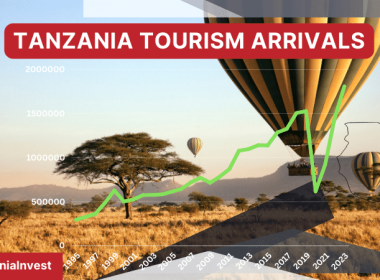
Tanzania Tourist Arrivals Reached Record-Breaking 1.8 Million in 2023
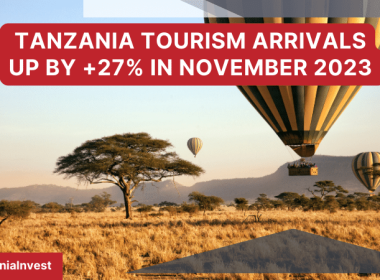
Tanzania Economic Review November 2023: Tourist Arrivals Up by +27%

Tanzania Economic Review October 2023: Export of Traditional Goods Almost Doubled Driven by Coffee and Tobacco

Tanzania Parks Signs Carbon Credit Deal

Tanzania Economic Review, September 2023: Tourism and Transport Receipts Up by 30.5%

Tanzania Economic Review, August 2023: Strong Growth in Coal Exports and Resilient Tourism Sector

Serengeti Voted Africa’s Leading National Park For The 5th Time

Tanzania Coal Exports Triple, Diamond Sales Up By 60%, and Tourism Hits Record High in YE July 2023
Tanzania tourism arrivals surpass 1.6 million in year ending may 2023, reaching historic heights.

Marriott to Open 5-Star Lodge in the Serengeti Park
Privacy overview.

Africa energy and utilities - Tax guide 2019

Oil and gas emerging tax issues

National budget 2020/21

Tax and VAT Newsletter
Loading Results
No Match Found
The future of Tourism in Tanzania
Let’s reimagine the future of tourism in tanzania.
Tanzania’s tourism sector is seeing a rebound after the Covid-19 pandemic—and the aspirations for its continued growth are high: by 2025, the country hopes to reach $6 billion in tourism revenue, which assumes the influx of five million tourists annually. To achieve such lofty goals will require some important upgrades and improvements to tourism infrastructure and services. I outline a few of them in this article.
Before the pandemic, tourism was the largest foreign exchange earner, the second largest contributor to the gross domestic product (GDP) and the third largest contributor to employment. After taking a severe hit during Covid, tourists are starting to return to Tanzania, with 742,133 visitors between January and July 2022, a 62.7% increase over the previous year (Exhibit 1).
Exhibit 1: Tourism is returning after the Covid-19 pandemic
But whilst we are doing well, many bottlenecks persist. These include limited access to cheap financing, inadequate tourism infrastructure, a multiplicity of levies, insufficient diversity in products offerings, and lack of sufficient hotel and airport facilities. So how can we measure how we are doing?
Well, the World Economic Forum (“WEF”) in its Travel & Tourism Development Index 2021 (published in May 2022, and themed “Rebuilding for a Sustainable and Resilient Future”) is one barometer of where we stand. It ranks Tanzania as 5 th of the sub-Saharan African (SSA) countries (and 81 st globally out of 117 countries, up from 86 th in 2019). 1 st to 4 th places within SSA are taken by Mauritius (62 nd ), South Africa (68 th ), Botswana (76 th ) and Kenya (78 th ), with 6 th to 10 th places taken by Cape Verde (82 nd ), Namibia (88 th ), Rwanda (89 th ), Zambia (98 th ) and Ghana (101 st ).
According to the WEF report Tanzania and South Africa are very clear leaders within SSA in terms of ranking of natural resources. One aspect to consider further as a significant opportunity is the “non-leisure resources” pillar, which measures the extent and attractiveness of factors that drive business and other non-leisure travel; although Tanzania’s ranking is broadly in line with the SSA average, it does lag Kenya and South Africa by quite a bit. More generally, the WEF report does highlight that East Africa as a region does not rank as highly as Southern Africa in terms of price competitiveness.
Exhibit 2: Tanzania can do more to boost its tourism competitiveness
Tourists coming to Tanzania frequently speak of seeing “the Big Five”. Stakeholders in the tourism sector would also say that they have their “Big Five” namely the “Five A’s”: Attractions, Access, Accommodation, Amenities, and Affordability! From my perspective, and aligned with this, I would highlight some priority areas that need to be addressed by the government and other stakeholders in the tourism sector.
Reduce multiplicity in levies and taxes . There is a need for a fresh look at tourism taxes and levies so as to reduce multiplicity and create competitiveness across the region – indeed, this point was highlighted as an urgent priority in a report recently presented at the 13 th meeting of the Tanzania National Business Council. Currently, Tanzania is deemed an expensive destination compared to other destinations such as South Africa and Kenya. Notwithstanding the positive efforts which led to reduction of some of the levies such as the Tourism Agency License (TALA) fee, there is still scope for rationalization of fees that are charged by multiple government agencies. Further, stakeholders’ engagement prior to fee changes will smoothen the operations of the tourism firms and attract more investments in the sector.
Affordable financing . Tourism firms across the sector, as well as those in downstream value chains, need access to affordable finance particularly in this post Covid-19 era, when the risk appetite for financial institutions in the tourism market is very low. Support from International Development Agencies (IDAs) on the tourism sector should be sought for development projects that have a direct economic impact on the sector and the country as whole.
Improved infrastructure . Tanzania ranks higher than Kenya with respect to safety and security, but lower than Kenya when it comes to tourist service infrastructure. For instance, the drive from Dar es Salaam to Selous Game Reserve, the largest game reserve in Africa is bumpy and long, taking an average of 7 to 8 hours. Flying is a better one option and the fastest way to get to Selous. However, it is the most expensive and hence suits more high-end tourists. Again, IDA support to improve tourist service infrastructure could give a welcome boost.
Upgraded hotels and airport facilities . More effort is required to attract private sector investment in hotels and ensure diversity in service offerings. The current hotel capacity in both Mainland and Zanzibar cannot cater for the expected influx of 5 million tourists by 2025. Improvement in efficiencies and flight handling capacity at the airports is another area which requires fixing. Automation of immigration procedures in Zanzibar and Kilimanjaro Airports will help fast track the process. Instead of having a paperwork checking system, barcodes should be set to scan all the documents. This will help to reduce unnecessary queues at the airports during high season.
Diversified tourism products . Other than wildlife and beaches, the Ministry for Tourism should spearhead the innovation of new tourist attractions. The recent decision to market Ngorongoro-Lengai geo park and the introduction of “Mice” (meetings, incentives, conferences, and exhibitions) are commendable efforts as these will boost tourism income, since Tanzania is an already established adventure destination.
Introduction of direct flights and collaborations with aviation industry . The signing of a memorandum of understanding between the Tanzanian Government and Dallas in April 2022 was one of the great achievements of the Royal Tour of the United States by her Excellency Samia Suluhu Hassan, as this will attract more American visitors to Tanzania's tourist destinations. More direct flights need to be added to key markets while maintaining a closer collaboration between the aviation and tourism industries for sustainable growth of the sector. This will ease flight interconnectivity to tourists who prefer to do inter-connected travels.
Raising public awareness . More education is needed for the public and journalists to help promote the tourism sector. Although we are in the era of freedom of speech, care should be taken not to exaggerate unproven facts that are detrimental to the sector’s growth.
In conclusion, the target of $6 billion by 2025 is achievable—but it will require deliberate efforts to make it a reality. The President’s Royal Tour is expected to bring a significant boost to the numbers in 2022 and beyond. The tourism sector needs to be given the utmost priority due to its huge potential in transforming the country’s economy as the sector contributes significantly to foreign exchange and employment.
By Zainab Salome Msimbe is a Partner with PwC Tanzania

Pauline Koola
Manager, PwC Tanzania
Tel: +255 (0) 22 219 2000

© 2010 - 2024 PwC. All rights reserved. PwC refers to the PwC network and/or one or more of its member firms, each of which is a separate legal entity. Please see www.pwc.com/structure for further details.
- About Site Provider
- Cookie information
- Where We Work
Tanzania Economic Update: How to Transform Tourism into a More Sustainable, Resilient and Inclusive Sector
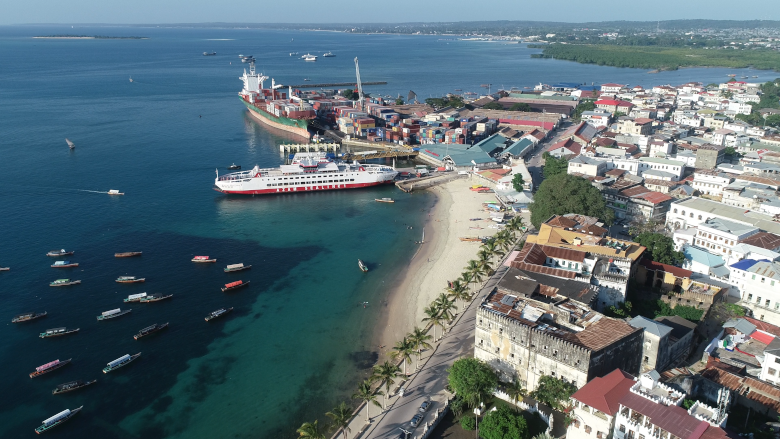
Stone Town, Zanzibar
Photo credit: Christian Morgan/World Bank.
STORY HIGHLIGHTS
- The latest Tanzania Economic Update highlights the huge untapped potential of the tourism sector to drive the country’s development agenda
- The new analysis discusses long-standing issues facing tourism in Tanzania as well as new challenges brought on by the COVID-19 pandemic
- The report says that the pandemic offers an opportunity for policy actions for the sector to recover in the near term and become a sustainable engine of private-sector-driven growth, social and economic inclusion, and climate adaptation and mitigation over the long term
DAR ES SALAAM, July 29, 2021— Tourism offers Tanzania the long-term potential to create good jobs, generate foreign exchange earnings, provide revenue to support the preservation and maintenance of natural and cultural heritage, and expand the tax base to finance development expenditures and poverty-reduction efforts.
The latest World Bank Tanzania Economic Update, Transforming Tourism: Toward a Sustainable, Resilient, and Inclusive Sector highlights tourism as central to the country’s economy, livelihoods and poverty reduction, particularly for women, who make up 72% of all workers in the tourism sector.
“Without tourism, the situation would be bad,” said Rehema Gabriel, a hotel attendant in Dar es Salaam. “I have been working in the tourism industry for eight years now, so I do not know what it would be like without it.”
The economic system around tourism had grown in value over the years and in 2019 was the largest foreign exchange earner, the second largest contributor to the gross domestic product (GDP) and the third largest contributor to employment, the report says. On the semiautonomous Zanzibar archipelago, the sector has also experienced rapid growth, accounting for almost 30% of the island’s GDP and for an estimated 15,000 direct and 50,000 indirect jobs. However, the report notes, only a small fraction of Tanzania’s natural and cultural endowments has been put to economic use through tourism development.
“Tourism offers countries like Tanzania, with abundant natural and cultural endowments, access to many foreign markets,” said Shaun Mann, World Bank Senior Private Sector Development Specialist and co-author of the Tanzania Economic Update. “But the absence of tourism revenues, as we have seen during this pandemic, compromises the integrity and viability of not only endowments, but also the economic, environmental and social ecosystems built up around those endowments.”
Amid the ongoing COVID-19 (coronavirus) pandemic, the World Bank estimates that Tanzania’s GDP growth decelerated to 2.0% in 2020. Business slowed across a wide range of sectors and firms, especially export-oriented sectors such as tourism and manufacturing. The report highlights the impact of the crisis on tourism specifically, which has had consequences beyond just the industry, given the many other sectors that support, and are supported by, tourism. The 72% drop in the sector’s revenues in 2020 (from 2019 levels) closed businesses and caused layoffs.
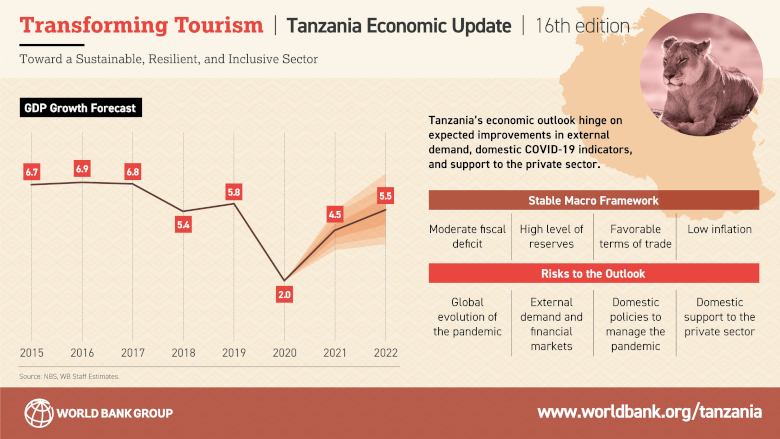
Zanzibar’s economy was even more severely impacted with GDP growth slowing to an estimated 1.3%, driven by a collapse of the tourism industry. As the hospitality industry shut down between March and September 2020, occupancy rates dropped to close to zero. While the Zanzibar tourism sector started slowly rebounding in the last quarter of 2020, with tourist inflows in December 2020 reaching almost 80% of those in 2019, receipts from tourism fell by 38% for the year.
As the tourism sector transitions gradually into recovery mode with the rest of the world, the report urges authorities to look toward its future resilience by addressing long running challenges that could help position Tanzania on a higher and more inclusive growth trajectory. Areas of focus include destination planning and management, product and market diversification, more inclusive local value chains, an improved business and investment climate and new business models for investment that are built on partnership and shared value creation.
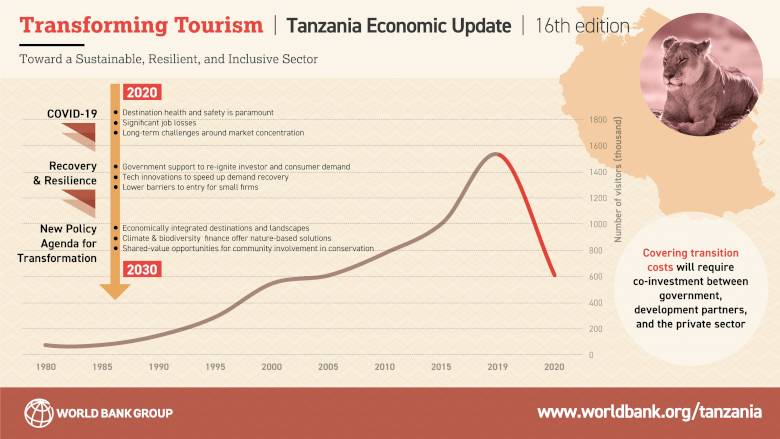
Tanzania is a globally recognized destination for nature-based tourism, a competitive market segment in eastern and southern Africa. Beyond attracting tourists, the country’s landscapes and seascapes produce a wide range of ecosystem services, including carbon sequestration and biodiversity co-benefits that are not efficiently priced and often generate little or no financial return. The global climate crisis has created significant demand for investment in these forms of natural capital, and Tanzania is well positioned to take advantage of nature-positive investment opportunities. The additional revenue derived from global climate programs could be an opportunity to ease the government’s fiscal constraints while also supporting the livelihoods of local communities.
“While restoring the trade and financial flows associated with tourism is an urgent priority, the disruption of the sector has created an opportunity to realign tourism development with economic, social, and environmental resilience,” said Marina Bakanova, World Bank Senior Economist, and co-author of the report. “The pandemic has created an opportunity to implement long-discussed structural reforms in the sector and use tourism as a leading example of improvement of the overall business climate for private investment.”
The authors suggest five priorities for a sustainable and inclusive recovery that lay the foundation for the long-term transformation of the tourism sector:
- Creating an efficient, reliable, and transparent business environment to reduce red tape and multiple distortions and inefficiencies, hindering decisions on private investments, domestic and foreign
- Establishing an information-management system that consolidates data from tourists and firms, enabling policymakers to improve sectoral planning and identify viable investment opportunities
- Ensuring that firms across the sector, as well as those in downstream value chains, have access to affordable transitional finance
- Consistently promoting, monitoring, and reporting on adherence to health and safety protocols.
- Developing co-investment and partnership arrangements to support nature-based landscape and seascape management
- Press Release: Tanzania has an Opportunity to Ignite Inclusive Economic Growth by Transforming its Tourism Sector
- Report: 16th Tanzania Economic Update: ‘Transforming Tourism: Toward a Sustainable, Resilient, and Inclusive Sector’
- Video: Launch event: 16th Tanzania Economic Update
- The World Bank in Tanzania
- The World Bank in Eastern and Southern Africa
- The World Bank in Africa
After the rebound in Tourism – what next?

By Zainab Salome
What you need to know:
- According to the Bank of Tanzania's monthly economic review of January 2024, the number of tourists who visited the country in the year ending 31 December 2023 amounted to 1,808,205, while the forex earnings reported record growth of USD 3.4 billion, an increase of 36% compared to the same period in 2022.
In 2023, Tanzania saw a tremendous bounce back in the tourism industry, with the number of tourist arrivals and revenues surpassing the pre-pandemic levels. How can we keep the momentum going, so as to make the most of tourism’s critical contribution to forex earnings and employment in the country, and do so sustainably?
Also read: Tourism grows swiftly as economy steams ahead
According to the Bank of Tanzania's monthly economic review of January 2024, the number of tourists who visited the country in the year ending 31 December 2023 amounted to 1,808,205, while the forex earnings reported record growth of USD 3.4 billion, an increase of 36% compared to the same period in 2022.
Tanzania's tourism hits record 1.8 million visitors as gold exports soar

Royal Tour boost as Ngorongoro set to collect Sh200 billion by June

Source: Ministry of Natural Resources and Tourism, 2022 and December 2023 BoT MER
The FYDP III articulates a target of 5 million tourists generating USD 6 billion by 2025. At first glance the revenue target seems more achievable than the arrivals target. Assuming the growth of 36 percent continues for the next two years, the receipts from tourist arrivals would reach USD 6. 3 billion by December 2025. In addition, if as a Country, we generated USD 3.4 billion with only 1.8 million tourist arrivals, one can argue that we do not need 5 million tourists to generate USD 6 billion. Therefore, the revenue target set by the Government at first glance does not look over ambitious.
Nevertheless, the maths suggest that the initial Government’s projections may need revision. By contrast, sector stakeholders have observed that the 5 million arrivals target would represent the equivalent of 50 Airbus planes (13,700 passengers) per day arriving in the country. Clearly, the current infrastructure of our airport facilities would not be able to accommodate such a volume. For instance, Kilimanjaro International Airport can hardly accommodate two Airbuses landing at the same time, hence multiplying the arrival numbers without putting in place adequate infrastructure does not seem realistic. This is not just a question about airport infrastructure, but supporting infrastructure more generally – for example, accommodation capacity.
What is clear is that there is a tremendous opportunity to build on the recent tremendous performance of the Tourism industry, so as to optimise the future of the sector. This is made clear in the recent World Bank’s Country Economic Memorandum for Tanzania (with the theme, “Privatizing Growth”) which listed five priority policy actions to enable sustained robust growth of the economy. One of these actions was titled “Building Tanzania’s tourism back better”. In this regard, its suggestions included: ensuring accessibility of areas beyond Zanzibar and the Northern Circuit; creating an enabling business environment for private sector investment by addressing longstanding regulatory and infrastructure bottlenecks; and identification of the new regions and new service offerings for the sector’s growth.
The Government's efforts to upgrade the airports in the southern areas, which include Iringa and Mbeya, are commendable as this is a step in the right direction in the development of Tourism in the south circuit. Further, new areas for tourism growth will generate positive economic impacts and ensure the distribution of economic benefits to the local communities. For instance, the coastal regions, Dar es Salaam, Tanga, and Pwani, enriched with beautiful beaches, historical and natural attractions, have an enormous potential to become new tourist destinations.
The bottlenecks pointed out in the World Bank Country Economic Memorandum are not new: they are shared by most if not all stakeholders in the Tourism sector including as summarised in a recent Tourism Confederation of Tanzania publication (titled “Overcoming Challenges in Tanzania’s Tourism Sector – A Report on Achieving Sustainable Growth in 2024”) and are similar to concerns I highlighted in a previous September 2022 article of mine. In summary, action is needed from the Government to ensure sustainable growth in the Tourism sector.
There are also lower-hanging fruits that can be addressed by players in the Tourism sector, such as quality of human resources. According to the World Economic Forum’s Travel and Tourism Development Index, Tanzania ranks 108th in the world on human resource and labour market. While the Government has a significant role to play in education as part of improving the quality of the labor force, the players in the sector should endeavor to invest in upskilling their workforce. As part of their socioeconomic development agenda, perhaps they could work together with International Development Agencies to come up with tourism academies?
The forex earnings from tourism as of December 2023 have proven that the target of $6 billion by 2025 is not beyond reach. Nevertheless, as a country, we should not be complacent. The tourism industry has to evolve and cater to diverse demands and emerging consumer behaviors focused on sustainable tourism demand.
By Zainab S. Msimbe, Partner – Assurance Services, PwC Tanzania
In the headlines
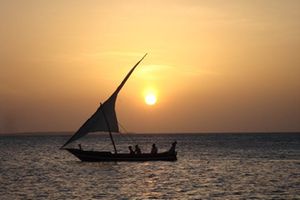
Dhow vanishes in the Indian ocean, five presumed dead
A dhow registered by the Zanzibar Maritime Authority (ZMA) as MV Tawakal III was reported missing as it was travelling from the port of Kilwa Kivinje, Lindi Region, to Malindi Port in Unguja.

Samia: Promote reconciliation, tolerance and reform for sustainable development
She has called for promoting reconciliation, tolerance and reform for the country to achieve sustainable growth.

Simba to seek revenge against Azam FC in Union Cup final
Tanzania Mainland giants, Simba SC, will seek revenge against Azam FC in the final match of the Union Cup on April 27, 2024, at the New Amaan Complex in Zanzibar.
A Critical Evaluation of Tanzania’s Tourism Sector
- First Online: 27 May 2022
Cite this chapter

- Evelyn F. Wamboye 3
668 Accesses
This chapter critically evaluates how Tanzania could increase the number of international tourists’ arrivals, and in turn, enhance the sector’s effectiveness in contributing to the country’s second 5-year development plan. It empirically investigates the relevant determinants of international tourism demand for Tanzania and uses the findings to inform evidence-driven policies. Results indicate that income of tourists and infrastructure development are the two main determinants of international tourism demand for Tanzania. Taking into consideration these findings; the government of Tanzania and stakeholders should work toward making Tanzania tourism products more competitive by developing/improving infrastructure in the country. Moreover, there should be a policy that encourages developing tourism products that fit the demands of tourists from relatively high-income countries, and also make conscious efforts to market these products in the target countries. Lowering the cost of living and improving the exchange rate are also some of the areas that the government could work on to help grow the tourism industry.
This is a preview of subscription content, log in via an institution to check access.
Access this chapter
- Available as PDF
- Read on any device
- Instant download
- Own it forever
- Available as EPUB and PDF
- Compact, lightweight edition
- Dispatched in 3 to 5 business days
- Free shipping worldwide - see info
- Durable hardcover edition
Tax calculation will be finalised at checkout
Purchases are for personal use only
Institutional subscriptions
Africa Economic Outlook (AEO) (2018), “Africa’s Macroeconomic Development and Structural Change in Africa” African Development Bank, Abidjan, Ivory Coast. Retrieved on May 1, 2018 from https://www.afdb.org/en/knowledge/publications/african-economic-outlook/ .
Agyeiwaah, Elizabeth, and Adongo, Raymond (2016), “Identifying Core Determinants of Tourism Demand in Hong Kong Inbound Markets” International Journal of Tourism Cities . Vol. 2(1), pp. 17–28.
Article Google Scholar
Akkemik, K. Ali (2012), “Assessing the Importance of International Tourism for the Turkish Economy: A Social Accounting Matrix Analysis” Tourism Management . Vol. 33(4), pp. 790–801.
Anderson, J. E., and Van Wincoop, E. (2003), “Gravity with Gravitas: A Solution to the Border Puzzle” American Economic Review. Vol. 93, pp. 170–192.
Andrés, A. T., Antonio, G. S., and Fransico, S. G. (2008), “The Length of Stay Determinants for Sun-and-Sand Tourism: An Application for the Region of Murcia” Journal Economic Literature . Vol. 16(1), p. 801.
Google Scholar
Bergstrand, J. H., and Egger, P. (2007). “A Knowledge-and-Physical-Capital Model of International Trade, Foreign Direct Investment, and Foreign Affiliate’s Sales: Developed Countries” Journal of International Economics . Vol. 73(2), pp. 278–308.
Bhagwati, J., and Srinivasan, T. (1979), “Trade Policy and Development.” In International Economic Policy: Theory and Evidence , edited by R. Dornbunsch and J. Frenkel. Baltimore, MD: Johns Hopkins University Press, pp. 1–35.
Brännäs, K., Hellström, J., and Jonas, Nordström. (2002), “A New Approach to Modelling and forecasting Monthly Guest Nights in Hotels” International Journal of Forecasting . Vol. 18(1), pp. 19–30.
Brida, J. G., and Scuderi, R (2013), “Determinants of Tourist Expenditure: A Review of Microeconometric Models” Tourism Management Perspectives . Vol. 6(April), pp. 28–40.
Bulin, Daniel, Miru, Nela, and Gheorghe, Georgica. (2014), “The Impact of Tourism Industry in the Economy” Knowledge Horizons . Vol 6(2), pp 74–79.
Burke, J. (2018), “Hundreds in Hiding as Tanzania Launches Anti-Gay Crackdown” The Guardian News and Media Limited United Kingdom. Retrieved on December 19, 2018 from https://www.theguardian.com/world/2018/nov/05/tanzania-gay-people-in-hiding-lgbt-activists-crackdown .
Castro-Nuno, Mercedes, Molina-Toucedo, Jose A., and Pablo-Romero, Maria P. (2013), “Tourism and GDP: A Meta-Analysis of Panel Data Studies” Journal of Travel Research . Vol. 52(6), pp 745–758.
Chao, C.-C., Lu, L.-J., Lai, C.-C., Hu, S.-W., and Wang, V. (2013), “Devaluation, Passthrough and Foreign Reserves Dynamics in a Tourism Economy” Economic Modelling , Vol. 30(1), pp. 456–461.
Christie, I. T., and Crompton, D. E. (2001), “Tourism in Africa” Africa Region Working Paper Series, No 12, World Bank, Washington, DC.
Cirstea, Stefan-Dragos, and Cristea, Adreea. (2015), “Economic and Social Importance of Tourism” Management Intercultural. Vol. 17(34), pp. 427–432.
Cleverdon, R. G. (2002), “Tourism Development in the SADC Region: The Opportunities and Challenges” Development Southern Africa. Vol. 19(1), pp. 7–28.
Culiuc, A. (2014), “Determinants of International Tourism” IMF Working Paper No. 14/82.
Davis, D., Allen, J., and Consenza, R. M. (1988), “Segmenting Local Residents by Their Attitudes, Interests, and Opinions Toward Tourism” Journal of Travel Research . Vol. 27, pp. 2–8.
Deardorff, A. V. (1998), “Determinants of Bilateral Trade: Does Gravity Work in a Neoclassical World?” In The Regionalization of the World Economy , edited by Jeffrey A. Frankel. University of Chicago Press.
Deaton A., and Muellbauer, J. (1980), “An Almost Ideal Demand System” American Economic Review. Vol. 70(3).
Deluna, R. Jr., and Jeon, N. (2014), Determinants of International Tourism Demand for the Philippines: An Augmented Gravity Model Approach. Available at: http://mpra.ub.unimuenchen.de/55294/ (accessed 06 April 2018).
De Vita, G., and Kyaw, K. S. (2013). “Role of the Exchange Rate in Tourism Demand” Annals of Tourism Research. Vol. 43, pp. 624–627.
Dinu, Ana-Maria (2017) “The Importance of Tourism and Touristic Services in GDP” Quaestus. April 2017(10), pp. 73–80.
Divisekera, Sarath (2007), Modelling and Estimation of Tourism Demand Elasticities: A Study of Tourist Expenditure Allocation in Australia. CRC for Sustainable Tourism Pty Ltd, Gold Coast, Qld. ISBN: 9781920965235.
Downward, P., and Lumsdon, L. (2003), “Beyond the Demand for Day-Visits: An Analysis of Visitor Spending” Tourism Economics. Vol. 9(1), pp. 67–76.
Dritsakis, N. (2004), “Cointegration Analysis of German and British Tourism Demand for Greece” Tourism Management. Vol. 25, pp. 111–119.
Durbarry, R. (2008), “Tourism Taxes: Implications for Tourism Demand in the UK” Review of Development Economics . Vol. 12, pp. 21–36.
Durden, G. C., and Silberman, J. (1975), “The Determinants of Florida Tourists Flows: A Gravity Model Approach” Review of Regional Studies . Vol. 5, pp. 31–41.
Dwyer, L., and Forsyth, P. (2002), “Destination Price Competitiveness: Exchange Rate Changes Versus Domestic Inflation” Journal of Travel Research. Vol. 40(3), pp. 328–336.
Eeckels, Bruno, Filis, George, and Leon, Costas (2012), “Tourism Income and Economic Growth in Greece: Empirical Evidence from Their Cyclical Components” Tourism Economics . Vol. 18(4), pp. 817–834.
Eichengreen, B., and Tong, H. (2007), “Is China’s FDI Coming at the Expense of Other Countries?” Journal of the Japanese and International Economies . Vol. 21, pp. 153–172.
Eilat, Y., and Einav, L. (2004), “The Determinants of International Tourism: A Three-Dimensional Panel Data Analysis” Applied Economics . Vol. 36(12), pp. 1315–1327.
Eugenio-Martin, J. L., Martín Morales, N., and Sinclair, M. T. (2008), “The Role of Economic Development in Tourism Demand” Tourism Economics . Vol. 14(4), pp. 673–690.
Fayissa, B., Nsiah, C., and Tadasse, B. (2008), “Impact of Tourism on Economic Growth and Development in Africa” Tourism Economics. Vol. 14, pp. 807–818.
Fourie, J., and Santana, M. (2011), “The Impact of Mega-Events on Tourist Arrivals” Tourism Management . Vol. 32, pp. 1364–1370.
Fourie, J., and Santana, M. (2013), “Cultural Affinity and Ethnic Reunion” Tourism Management . Vol. 36, pp. 411–420.
Fredman, P. (2008), “Determinants of Visitor Expenditures in Mountain Tourism” Tourism Economics , Vol. 14(2), pp. 97–311.
Garín-Munoz, T. (2009), “Tourism in Galicia: Domestic and Foreign Demand” Tourism Economics . Vol. 15(4), pp. 753–769.
Gatt, W., and Falzon, J. (2014), “British Tourism Demand Elasticities in Mediterranean Countries” Applied Economics. Vol. 46(29), pp. 3548–3561.
Gauci, A., Gerosa, V., and Mwalwanda, C. (2002), Tourism in Africa and the Multilateral Trading System: Challenges and Opportunities . Background Paper for the Economic Commission for Africa, Addis Ababa.
Gil-Pareja, S., Llorca, R., and Martínez, J. A. (2006), “The Impact of Embassies and Consulates on Tourism” Tourism Management . Vol. 28, pp. 355–360.
Gil-Pareja, S., Llorca, R., and Martínez, J. A. (2007), “The Effect of EMU on Tourism” Review of International Economics. Vol. 15, pp. 302–312.
Gordon, I. R., Edwards, S. L. (1973). “Holiday Trip Generation” Journal of Transport Economics and Policy , May, 153–168.
Hanafiah, M. H. M., and Harun, M. F. M. (2010), “Tourism Demand in Malaysia: A Cross-Sectional Pool Time-Series Analysis” International Journal of Trade, Economics, and Finance . Vol. 1(1), pp. 80–83.
Head, K., and Ries, J. (2008), “FDI as an Outcome of the Market for Corporate Control: Theory and Evidence” Journal of International Economics . 74, pp. 2–20.
Helpman, E., and Krugman, P. (1985), Market Structure and Foreign Trade . Cambridge: MIT Press.
Karemera, D., Oguledo, V. I., and Davis, B. (2000), “A Gravity Model Analysis of International Migration to North America” Applied Economics. Vol. 32, pp. 1745–1755.
Kasapi, Irisi and Koc, Macit. (2012), “Changing Tourism Consumer Behavior: The Impacts on Tourism Demand” Creative and Knowledge Society . Vol. 2 (2).
Kester, J. G. C. (2003), “International Tourism in Africa” Tourism Economics . Vol 9(2), pp. 203–221.
Keum, K. (2010), “Tourism Flows and Trade Theory: A Panel Data Analysis with the Gravity Model” The Annals of Regional Science . Vol. 44, pp. 541–557.
Khadaroo, J., and Seetanah, B. (2008), “The Role of Transport Infrastructure in International Tourism Development: A Gravity Model Approach” Tourism Management . Vol. 29, pp. 831–840.
Kimura, F., and Lee, H.-H. (2006), “The Gravity Equation in International Trade in Services” Review of World Economics . Vol. 142, pp. 92–121.
Kliman, M. L. (1981), “A Quantitative Analysis of Canadian Overseas Tourism” Transportation Research . Vol. 15, pp. 487–497.
Kosnan, S. S. A., Ismail, N. W., and Kaniappan, S. R. (2013), “Demand Factors for International Tourism in Malaysia” Jurnal Ekonomi Malaysia . Vol. 47(1), pp. 131–138.
Krueger, A. (1980), “Trade Policy as an Input to Development” American Economic Review . Vol. 70, pp. 188–292.
Kweka, Josaphat, Morrissey, Oliver, and Blake, Adam (2003), “The Economic Potential of Tourism in Tanzania” Journal of International Development . Vol. 15 (2003), 335–351.
Lee, C.-K., Var, T., and Blaine, T. W. (1996), “Determinants of Inbound Tourist Expenditures” Annals of Tourism Research . Vol. 23(3), pp. 527–542.
Leitao, N. C. (2010), “Does Trade Help to Explain Tourism Demand? The Case of Portugal” Theoretical and Applied Economics . Vol. 3(544), pp. 63–74.
Levin, Andrew, Lin, Chien-Fu, and James Chu, Chia-Shang (2002), “Unit Root Tests in Panel Data; Asymptotic and Finite Sample Properties” Journal of Econometrics . Vol. 108(1), pp. 1–24.
Li, G., Song, H., and Witt, S. F. (2005), “Recent Developments in Econometric Modeling and Forecasting” Journal of Travel Research. Vol. 44, pp. 82–99.
Lim, C. (1997a), “Review of International Tourism Demand Models” A nnals of Tourism Research. Vol 24(4), pp. 835–849.
Lim, C. (1997b), “An Econometric Classification and Review of International Tourism Demand Models” Tourism Economics . Vol 3(1), pp. 69–81.
Lim, C. (1999), “A Meta-Analytic Review of International Tourism Demand” Journal of Travel Research . Vol. 37, pp. 273–284.
Luvanga, N., and Shitundu, J. M., (REPOA 2003), The Role of Tourism in Poverty Alleviation in Tanzania. Dar es Salaam Tanzania: Mkuki na Nyota Publishers.
Marshall, M., and Jaggers, K. (2011), Polity IV Project: Political Regime Characteristics and Transitions, 1800–2010 . College Park, MD: Center for International Development and Conflict Management, University of Maryland.
Martinez-Garzia and Raya, J. M. (2008). “Length of Stay for Low Cost Tourism” Tourism Management. Vol. 29, pp. 1064–1075.
Martins, Luis F., Gan, Yi, and Ferreira-Lopes, Alexandra. (2017), “An Empirical Analysis of the Influence of Macroeconomic Determinants on World Tourism Demand” Tourism Management . Vol. 61(2017), pp. 248–260.
McConnell, K. E. (1992), “On-Site Time in the Demand for Recreation” American Journal of Agricultural Economics. Vol. 74, pp. 918–925.
Ministry of Natural Resources and Tourism (MNRT). (2017), “Environmental and Social Management Framework for the Resilient Natural Resources Management for Tourism and Growth Project”. P150523-PPA-C-07. Dar es Salaam, Tanzania. Retrieved on May 1, 2018 from http://tawiri.or.tz/regrow-project/ .
Ministry of Natural Resources and Tourism (MNRT). (1999). Tanzania National Tourism Policy (1999). Dar es Salaam, Tanzania. Retrieved on May 1, 2018 from https://www.maliasili.go.tz/resources/view/tanzanianational-tourism-policy-1999 .
Mitchell, J., and Ashely, C. (2006), “Can Tourism Help Reduce Poverty in Africa?” ODI Opinion No. 81. June.
Moorthy, R (2014), “An Empirical Analysis of Demand Factors for Malaysian Tourism Sector Using Stochastic Methods” Review Integrative Business Economic Research . Vol. 3(2), pp. 255–267.
Morley, C. L. (1992), “A Microeconomic Theory of International Tourism Demand” Annals of Tourism Research . Vol. 19, pp. 250–267.
Morley, C., Rosselló, J., and Santana-Gallego, M. (2014), “Gravity Models for Tourism Demand: Theory and Use” Annals of Tourism Research. Vol. 48, pp 1–10.
Muchapondwa, Edwin and Stage, Jesper. (2013), “The Economic Impacts of Tourism in Botswana, Namibia and South Africa: Is Poverty Subsiding?” Natural Resources Forum . Vol. 37(2).
Naudé, W. A., and Saayman, A. (2005), “The Determinants of Tourist Arrivals in Africa: A Panel Data Regression Analysis” Tourism Economics . Vol. 11(3), pp. 365–391.
Neumayer, E. (2010). “Visa Restrictions and Bilateral Travel” The Professional Geographer . Vol. 62(2), pp. 171–181.
Neves, Diana C., Fernandes, Antonio, J., and Pereira, Elisabeth, T. (2015), “Determinants of Touristic Attraction in Portuguese Regions and Their Impact on GDP” Tourism Economics . Vol. 21 (3), pp. 629–648.
Ng’wanakilala, F. (2016), “Tanzania's President Threatens Crackdown on Opposition Protesters” Thomson Reuters, NY, USA. Retrieved on December 19, 2018 from https://www.reuters.com/article/us-tanzania-politics-idUSKCN10925G .
Nyabola, N. (2018), “Freedom of Expression in Tanzania Is Slowly Being Eroded” Al Jazeera's News, Qatar. Retrieved on December 19, 2018 from https://www.aljazeera.com/indepth/opinion/freedom-expression-tanzania-slowly-eroded-181104131453497.html .
Odhiambo, N. M. (2011), Tourism Development and Economic Growth in Tanzania: Empirical Evidence from the ARDL-Bounds Testing Approach. Doctoral Dissertation. University of South Africa
Oh, Chi-Ok and Ditton, Robert, B. (2006), “Using Recreation Specialization to Understand Multi-Attribute Management” Leisure and Sciences: An Interdisciplinary Journal . Vol. 28(4), pp. 369–384.
Onder, Ozlem A., Candemir, Aykan and Kumral, Nese. (2009), “An Empirical Analysis of the Determinants of International Tourism Demand” European Planning Studies . Vol. 17(10), pp. 1525–1533.
Prideaux, B. (2005), “Factors Affecting Bilateral Tourism Flows” Annals of Tourism Research . Vol. 32, pp. 780–801.
Provencher, B., and Bishop, R. C. (1997), “An Estimable Dynamic Model of Recreation Behavior with an Application to Great Lakes Angling” Journal of Environmental Economics and Management . Vol. 33, pp. 107–127.
Pyers, C. E. (1966), “Evaluation of Intervening Opportunities Trip Distribution Model” Highway Research Record . Vol. 114, pp. 71–98.
Quandt, R. E., and Baumol, W. J. (1969), “The Demand for Abstract Transport Modes: Some Hopes” Journal of Regional Science. Vol. 9, pp. 159–162.
Saayman, Andrea, and Cortes-Jimenez, Isabel (2013) “Modelling Intercontinental Tourism Consumption in South Africa: A Systems-of Equations Approach” South African Journal of Economics . Vol. 81(4). Online.
Saayman, Andrea and Melville, Saayman (2015), “An ARDL Bounds Test Approach to Modelling Tourist Expenditure in South Africa” Tourism Economics . Vol. 21(1), pp. 49–66.
Saayman, Andrea, and Saayman, Melville (2013), “Exchange Rate Volatility and Tourism—Revisiting the Nature of the Relationship” European Journal of Tourism Research. Vol. 6(2), pp. 104–121.
Saayman, Melville, Rossouw, Riaan, and Krugell, Waldo (2012), “The Impact of Tourism on Poverty in South Africa” Development Southern Africa . Vol. 29(3), pp. 462–487.
Saayman, A., and Saayman, M. (2008), “The Determinants of Inbound Tourism to South Africa” Tourism Economics . Vol 14(1), pp. 81–96.
Salleh, N. H. M., and Hook L. S., Ramachandran, S., et al. (2008), “Asian Tourism Demand for Malaysia: A Bound Test Approach” Contemporary Management Research . Vol. 4(4), pp. 351–368.
Santana, M., Ledesma, F. J., and Pérez, J. V. (2010), “Exchange Rate Regimes and Tourism” Tourism Economics . Vol. 16, pp. 25–43.
Santana, M., Ledesma, F. J., Pérez, J. V., and Cortés, I. (2010), “Does a Common Currency Promote Countries’ Growth Via Trade and Tourism”? The World Economy . Vol. 33, pp. 1811–1835.
Schwikowski, M. (2017), “Political Climate Worsens Amid Crackdown on Opposition” DW Akademie, Germany. Retrieved on December 19, 2018 from https://www.dw.com/en/tanzania-political-climate-worsens-amid-crackdown-on-opposition/a-40422844 .
Seetanah, Boopen, Durbarry, Ramesh, and Ragodoo, Nicolas J .F. (2010), “Using the Panel Cointegration Approach to Analyse the Determinants of Tourism Demand in South Africa” Tourism Economics . Vol. 16(3), pp. 715–729.
Song, H., and Li, G. (2008), “Tourism Demand Modeling and Forecasting—A Review of Recent Research” Tourism Management . Vol. 29, pp. 203–220.
Song, H., Li, G., Witt, S.F., and Fei, B. (2010), “Tourism Demand Modeling and Forecasting: How Should Demand Be Measured?” Tourism Economics. Vol. 16(1), pp. 63–82.
Song, H., Li, G., Witt, S. F., and Fei, B. (2016), “Tourism Demand Modelling and Forecasting: How Should Demand Be Measured?” Tourism Economics. Vol. 16(1), pp. 63–81.
Sopelsa, B. (2018), “U.S. ‘Deeply Concerned’ About Tanzania's Anti-LGBTQ Crackdown” NBC News Digital, N.Y, USA, Retrieved on December 19, 2018 from https://www.nbcnews.com/feature/nbc-out/u-s-deeply-concerned-about-tanzania-s-anti-lgbtq-crackdown-n934946 .
Tang, Chor Foon and Tan, Eu Chye (2016), “The Determinants of Inbound Tourism Demand in Malaysia: Another Visit with Non-Stationary Panel Data Approach” An International Journal of Tourism and Hospitality Research . Vol. 27(2).
Tanzania Tourism Sector Survey (2014), “The 2014 International Visitors’ Exit Report” Ministry of Natural Resources and Tourism. Dar es Salaam, Tanzania.
Tanzania Tourism Sector Survey (2016), “The 2016 International Visitors’ Exit Report” Ministry of Natural Resources and Tourism. Dar es Salaam, Tanzania.
Taplin, J., and Qiu, M. (1997), “Car Trip Attraction and Route Choice in Australia” Annals of Tourism Research . Vol. 24, pp. 624–637.
Tavares, Jean Max, and Leitao, Nuno Carlos (2017), “The Determinants of International Tourism Demand for Brazil” Tourism Economics . Vol. 23(4), pp. 834–845.
Thacker, Nita, Acevedo, Sebastian, and Perrelli, Roberto (2012), “Caribbean Growth in an International Perspective: The Role of Tourism” IMF Working Paper No WP/12/235. International Monetary Fund. ISBN 9781475510898.
Tourism Statistical Bulletin (2015). Ministry of Natural Resources and Tourism, Dar es Salaam, Tanzania.
Tourism Statistical Bulletin (2016). Ministry of Natural Resources and Tourism, Dar es Salaam, Tanzania.
Tourism Statistical Bulletin (2017). Ministry of Natural Resources and Tourism, Dar es Salaam, Tanzania.
United Nation World Tourism Organization (UNWTO) (2012), Tourism highlights. Madrid, Spain.
United Nation World Tourism Organization (UNWTO) (2016), Tourism highlights. Madrid, Spain.
United Republic of Tanzania, Economic Survey Report (2017), Ministry of Finance and Planning, Dar es Salaam Tanzania.
United Republic of Tanzania, National Tourism Policy (1999), Ministry of Natural Resources and Tourism, Dar es Salaam, Tanzania.
Untong, A., Ramos, V., Kaosa-Ard, M., and Rey-Maquieira, J. (2015), “Tourism Demand Analysis of Chinese Arrivals in Thailand” Tourism Economics. Vol. 21(6), pp. 1221–1234.
Usta, Ö. (2008), Turizm Genel ve Yapısal Yaklasim (Ankara: Detay Yayıncılık).
Varian, H. R. (1992), Microeconomics Analysis . New York: W W Norton & Company, Inc.
Vietze, C. (2012), “Cultural Effects on Inbound Tourism Into the USA: A Gravity Approach” Tourism Economics . Vol. 18, pp. 121–138.
Wanjiru, E. (2018), “Freedom of Expression ‘Deteriorating’ Under Magufuli” DW Akademie, Germany. Retrieved on December 19, 2018 https://www.dw.com/en/tanzania-freedom-of-expression-deteriorating-under-magufuli/a-43423391 .
WEF-TTCR (2017), Travel and Tourism Competitive Report, 2017. World Economic Forum. Retrieved on December 18, 2018 from http://www3.weforum.org/docs/WEF_TTCR_2017_web_0401.pdf .
World Bank (2006), “Ethiopia—Towards a Strategy for Pro-Poor Tourism Development”. PSD, Privatization and Industrial Policy. Report No. 38420. World Bank Group, Washington, DC. Retrieved on February 1, 2018 from http://documents.worldbank.org/curated/en/463631468256450819/Ethiopia-towards-a-strategy-for-propoor-tourism-development .
World Travel and Tourism Council (WTTC)— Tanzania (2017), “Travel and Tourism Economic Impact 2017, Tanzania” Travel and Tourism Council, London, UK.
World Travel and Tourism Council (WTTC) (2017), “Travel and Tourism Economic Impact” Travel and Tourism Council, London, UK.
Download references
Author information
Authors and affiliations.
Department of Economics, Pennsylvania State University DuBois, DuBois, PA, USA
Evelyn F. Wamboye
You can also search for this author in PubMed Google Scholar
Corresponding author
Correspondence to Evelyn F. Wamboye .
Editor information
Editors and affiliations.
Department of Economics and Finance, Middle Tennessee State University, Murfeesboro, TN, USA
Bichaka Fayissa
See Tables 11 , 12 , 13 , 14 , 15 , 16 , 17 , and 18 .
Rights and permissions
Reprints and permissions
Copyright information
© 2022 The Author(s), under exclusive license to Springer Nature Switzerland AG
About this chapter
Wamboye, E.F. (2022). A Critical Evaluation of Tanzania’s Tourism Sector. In: Wamboye, E.F., Fayissa, B. (eds) The Palgrave Handbook of Africa’s Economic Sectors. Palgrave Macmillan, Cham. https://doi.org/10.1007/978-3-030-75556-0_11
Download citation
DOI : https://doi.org/10.1007/978-3-030-75556-0_11
Published : 27 May 2022
Publisher Name : Palgrave Macmillan, Cham
Print ISBN : 978-3-030-75555-3
Online ISBN : 978-3-030-75556-0
eBook Packages : Economics and Finance Economics and Finance (R0)
Share this chapter
Anyone you share the following link with will be able to read this content:
Sorry, a shareable link is not currently available for this article.
Provided by the Springer Nature SharedIt content-sharing initiative
- Publish with us
Policies and ethics
- Find a journal
- Track your research
- Sitemap ›
- Africa ›
- Tanzania ›
- Travel, Tourism & Hospitality

Statistics about Travel, Tourism & Hospitality in Tanzania
- Hotel room revenue in Tanzania 2013-2023
- RevPAR of hotel industry in Tanzania 2013-2023
- Available hotel rooms in Tanzania 2013-2023
- Occupancy rate of hotels in Tanzania 2013-2023
- Average daily rate (ADR) of hotels in Tanzania 2013-2023
- Number of tourists staying in hotels in Tanzania 2015-2020
- Bed occupancy rate of hotels in Tanzania 2019-2020
- Share of international visitors in hotels occupancy in Tanzania 2020
- Bed nights occupied in hotels of Tanzania 2019-2020
- Most visited national parks in Tanzania 2019
- Revenue generated by visits to national parks in Tanzania 2015-2019
- Number of visitors to national parks in Tanzania 2015-2019, by type
- Average expense at selected beach destinations in Tanzania, by cost factor 2018
- Main nationalities of tourists arriving in Tanzania 2021
- Average tourist expenditure in Tanzania 2015-2020
- Tourist arrivals in Tanzania 2015-2022
- Main countries of origin of international visitors in Zanzibar 2021
- International visitors in Zanzibar 2015-2021
- Earnings from visitors at tourist attraction sites in Tanzania 2021, by zone
- Visitors at national parks in Tanzania 2020-2021, by geographical zone
- Tanzania's visa openness to African visitors 2021
Travel, Tourism & Hospitality
- Contribution of travel and tourism to GDP in Tanzania 2019-2021
Contribution of travel and tourism to Gross Domestic Product (GDP) in Tanzania from 2019 to 2021
Additional Information
Show sources information Show publisher information Use Ask Statista Research Service
2019 to 2021
Other statistics on the topic
Geography & Nature
- Highest mountains in Africa
- International visitors in Zanzibar 2015-2021
- Main countries of origin of international visitors in Zanzibar 2021
- Tourist arrivals in Tanzania 2015-2022

- Immediate access to statistics, forecasts & reports
- Usage and publication rights
- Download in various formats
You only have access to basic statistics.
- Instant access to 1m statistics
- Download in XLS, PDF & PNG format
- Detailed references
Business Solutions including all features.
Statistics on " Travel and tourism in Tanzania "
- International tourist arrivals in Africa 2020, by country
- Monthly tourist arrivals in Tanzania 2019-2022
- Main nationalities of tourists arriving in Tanzania 2021
- Average tourist expenditure in Tanzania 2015-2020
- Value added of travel and tourism to GDP in Tanzania 2019-2021
- Tourism receipts in Tanzania from 2020-2022
- International and domestic visitor spending in Tanzania 2019-2021
- Share of employment in travel and tourism in Tanzania 2019-2021
- Highest-rated safari parks in Africa 2021
- World Heritage Sites in Africa 2021, by country
- Most visited national parks in Tanzania 2019
- Revenue generated by visits to national parks in Tanzania 2015-2019
- Visitors at national parks in Tanzania 2020-2021, by geographical zone
- Earnings from visitors at tourist attraction sites in Tanzania 2021, by zone
- Hotel occupancy rate in Africa 2021-2023
- Bed occupancy rate of hotels in Tanzania 2019-2020
- Number of tourists staying in hotels in Tanzania 2015-2020
- Bed nights occupied in hotels of Tanzania 2019-2020
- Share of international visitors in hotels occupancy in Tanzania 2020
- Monthly international arrivals in Zanzibar 2018-2021
- Hotel beds available in Zanzibar 2020-2021
- Bed occupancy rate in Zanzibar 2020-2021
- GDP of hotels and food services in Zanzibar 2016-2020
- Share of hotels and food services in Zanzibar's GDP 2016-2020
Other statistics that may interest you Travel and tourism in Tanzania
- Premium Statistic International tourist arrivals in Africa 2020, by country
- Premium Statistic Tourist arrivals in Tanzania 2015-2022
- Premium Statistic Monthly tourist arrivals in Tanzania 2019-2022
- Basic Statistic Main nationalities of tourists arriving in Tanzania 2021
- Premium Statistic Average tourist expenditure in Tanzania 2015-2020
Economic impact
- Basic Statistic Contribution of travel and tourism to GDP in Tanzania 2019-2021
- Basic Statistic Value added of travel and tourism to GDP in Tanzania 2019-2021
- Basic Statistic Tourism receipts in Tanzania from 2020-2022
- Basic Statistic International and domestic visitor spending in Tanzania 2019-2021
- Basic Statistic Share of employment in travel and tourism in Tanzania 2019-2021
Attractions
- Premium Statistic Highest-rated safari parks in Africa 2021
- Basic Statistic Highest mountains in Africa
- Basic Statistic World Heritage Sites in Africa 2021, by country
- Premium Statistic Most visited national parks in Tanzania 2019
- Premium Statistic Revenue generated by visits to national parks in Tanzania 2015-2019
- Basic Statistic Visitors at national parks in Tanzania 2020-2021, by geographical zone
- Basic Statistic Earnings from visitors at tourist attraction sites in Tanzania 2021, by zone
Accommodation
- Premium Statistic Hotel occupancy rate in Africa 2021-2023
- Premium Statistic Bed occupancy rate of hotels in Tanzania 2019-2020
- Premium Statistic Number of tourists staying in hotels in Tanzania 2015-2020
- Premium Statistic Bed nights occupied in hotels of Tanzania 2019-2020
- Premium Statistic Share of international visitors in hotels occupancy in Tanzania 2020
Special focus: Zanzibar
- Premium Statistic International visitors in Zanzibar 2015-2021
- Premium Statistic Monthly international arrivals in Zanzibar 2018-2021
- Premium Statistic Main countries of origin of international visitors in Zanzibar 2021
- Premium Statistic Hotel beds available in Zanzibar 2020-2021
- Premium Statistic Bed occupancy rate in Zanzibar 2020-2021
- Premium Statistic GDP of hotels and food services in Zanzibar 2016-2020
- Premium Statistic Share of hotels and food services in Zanzibar's GDP 2016-2020
Further related statistics
- Basic Statistic Global travel and tourism expenditure 2019-2022, by type
- Basic Statistic Forecast: economic contribution of travel and tourism to GDP worldwide 2020-2029
- Premium Statistic Average daily expenditure of Australian residents traveling to Italy 2010-2017
- Premium Statistic Average daily expenditure of German residents traveling to Italy 2010-2017
- Premium Statistic Average daily expenditure of Russian residents traveling to Italy 2010-2017
- Premium Statistic Average daily expenditure of UK residents traveling to Italy 2010-2017
- Premium Statistic Average daily expenditure of American residents traveling to Italy 2010-2017
- Basic Statistic Average daily expenditure of Canadian residents traveling to Italy 2010-2017
- Premium Statistic Average daily expenditure of Austrian residents traveling to Italy 2010-2017
- Premium Statistic Average daily expenditure of Chinese residents traveling to Italy 2010-2017
- Premium Statistic Average daily expenditure of French residents traveling to Italy 2010-2017
- Premium Statistic Average daily expenditure of Japanese residents traveling to Italy 2010-2017
- Premium Statistic Value of USA arms agreements Egypt 1970-2017
- Premium Statistic Volume of talc produced in Nigeria 2015-2020
- Premium Statistic Overnight stays of international tourists in Tunisia 2019, by hotel rating
Further Content: You might find this interesting as well
- Global travel and tourism expenditure 2019-2022, by type
- Forecast: economic contribution of travel and tourism to GDP worldwide 2020-2029
- Average daily expenditure of Australian residents traveling to Italy 2010-2017
- Average daily expenditure of German residents traveling to Italy 2010-2017
- Average daily expenditure of Russian residents traveling to Italy 2010-2017
- Average daily expenditure of UK residents traveling to Italy 2010-2017
- Average daily expenditure of American residents traveling to Italy 2010-2017
- Average daily expenditure of Canadian residents traveling to Italy 2010-2017
- Average daily expenditure of Austrian residents traveling to Italy 2010-2017
- Average daily expenditure of Chinese residents traveling to Italy 2010-2017
- Average daily expenditure of French residents traveling to Italy 2010-2017
- Average daily expenditure of Japanese residents traveling to Italy 2010-2017
- Value of USA arms agreements Egypt 1970-2017
- Volume of talc produced in Nigeria 2015-2020
- Overnight stays of international tourists in Tunisia 2019, by hotel rating
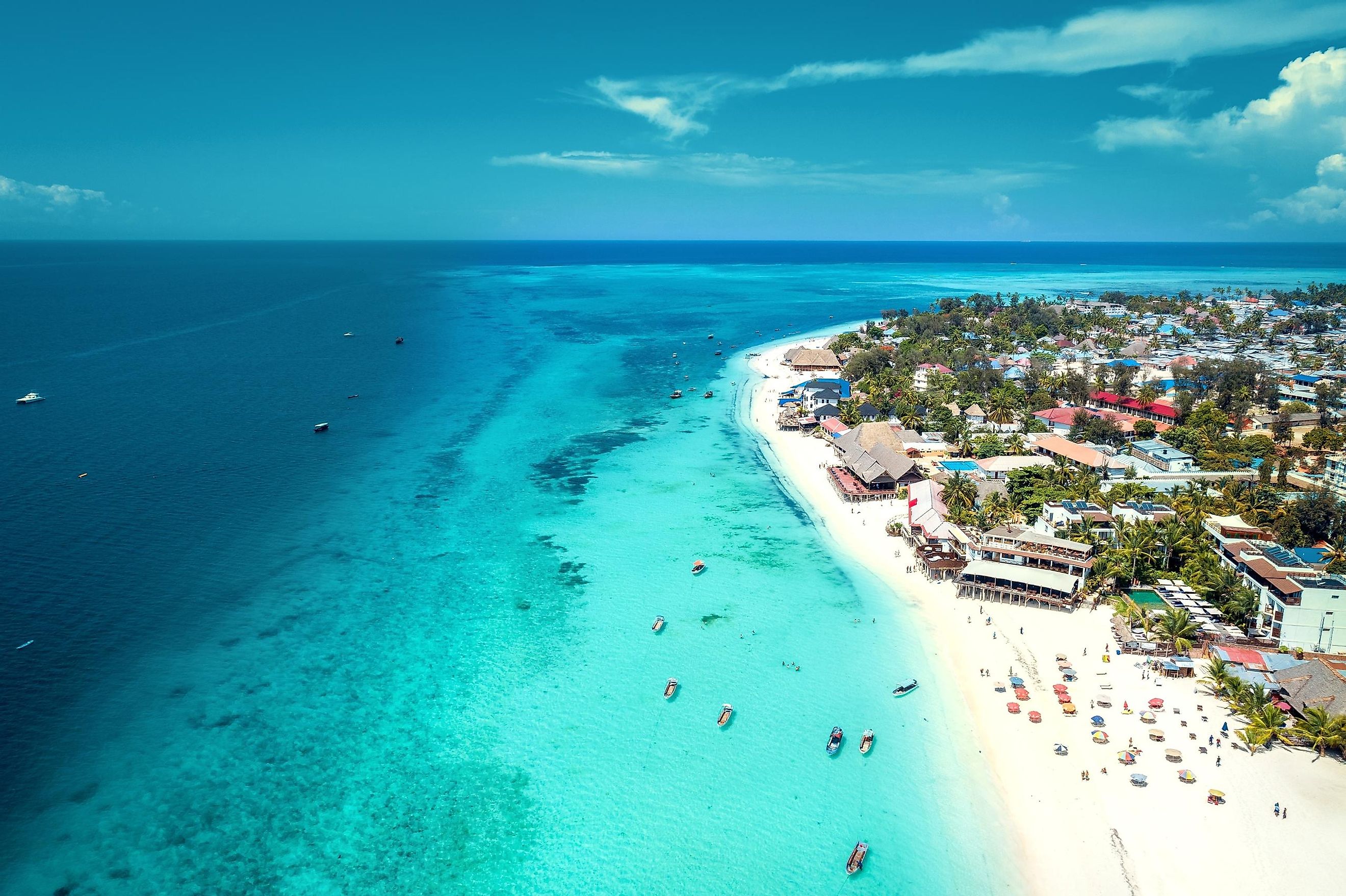
8 Most Charming Places in Tanzania
Found along the coast of East Africa is the great nation of Tanzania . Not the most well-known country in Africa, Tanzania has quietly become one of the upstart places in Africa, boasting a burgeoning and booming tourism industry. Known for its breathtaking landscape, white sand beaches, and vibrant culture, Tanzania is surely to make a good first impression.
Ruaha National Park
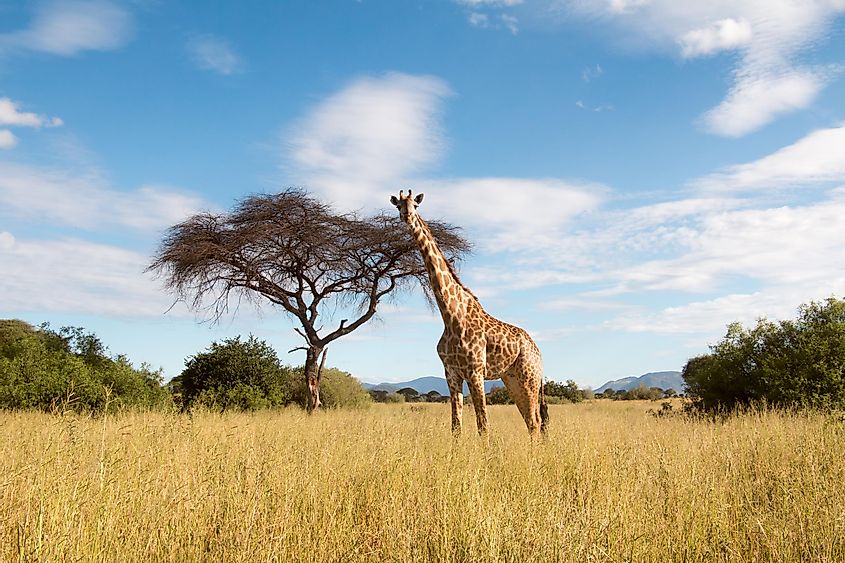
Ruaha National Park is the largest nature reserve in Tanzania. In 2008, it merged with the neighboring Usangu Game Reserve, now covering more than 20,000km². There are campsites located all over the park, which make for perfect vantage points from which to see the wildlife up close.
Going on a safari here is like no other. There are endless ways to explore the park, all with a warm and helpful guide to help along the way. Most of these safaris are done from the safety of a car, whereas others are conducted on boats. The animals that you will see and the people that you will meet are going to create memories that last a lifetime.
Mahale Mountains National Park
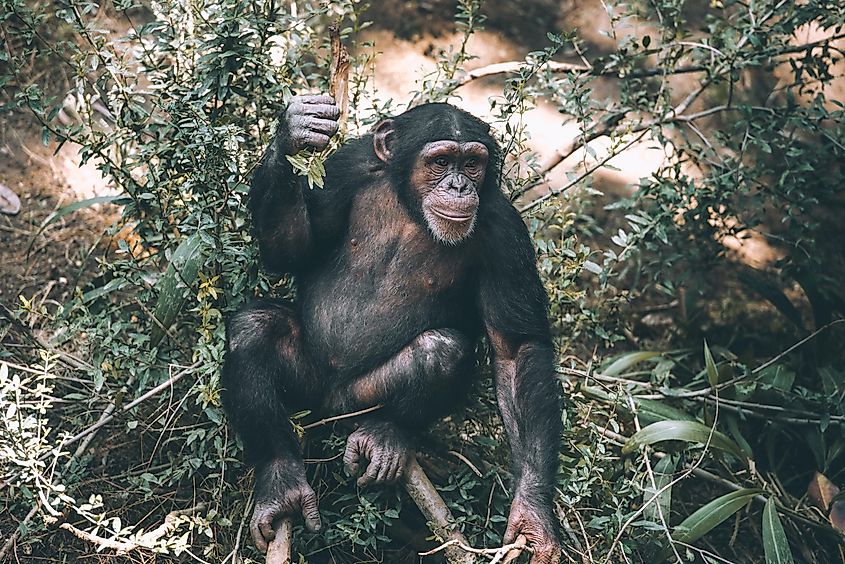
Another one of Tanzania's stellar national parks, the Mahale Mountains, is located along the tranquil shores of Lake Tanganyika in eastern Tanzania. Initially created to protect a large segment of Tanzania's chimpanzee population, the park has become a world-class tourist destination.
The Greystone Mahale Camp is particularly stunning. This one-of-a-kind lodge is the perfect place to go on a romantic getaway with your significant other. There are, of course, plenty of guided tours inland to observe and occasionally interact with the various groups of chimpanzees that call the park home.
Nyerere National Park
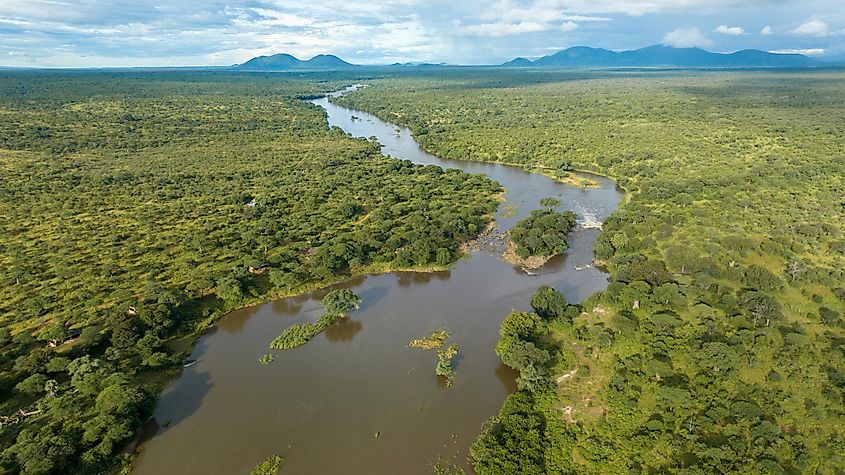
Located on in Eastern Tanzania, the Nyerere National Park transports its guests into the thick of the African savannah . Guests can enjoy this park any way they want. There are traditional safaris, boat safaris, and even the option to survey the park from a hot air balloon.
Tours into the bush are also available. This allows guests to observe the wildlife up close and personal. It also gives visitors the chance to visit some of the remote villages that are located within the park. The locals here are famous for their warm demeanor and hospitality .
Mafia Island
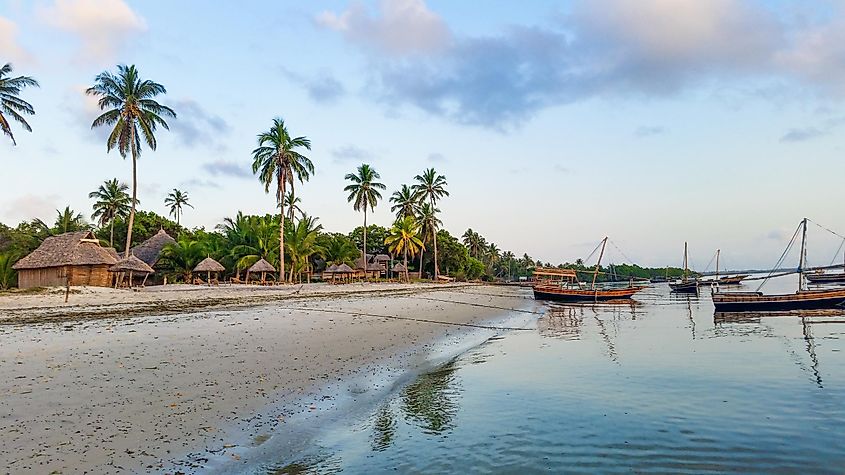
Despite its name having a somewhat foreboding name, Mafia Island couldn't be further removed from any semblance of violence or organized crime. Located along the east coast of Tanzania, Mafia Island's pristine beaches and crystal blue water are nothing short of magical.
Mafia Island's beaches are a hotspot for nesting turtles, and its shallow waters teem with marine life. For those daring enough, the best months to spot whale sharks are from October to February. Even if aquatic life is not to your taste, the laid-back and peaceful nature of the island is enough to make this a once-in-a-lifetime trip.
Mount Kilimanjaro
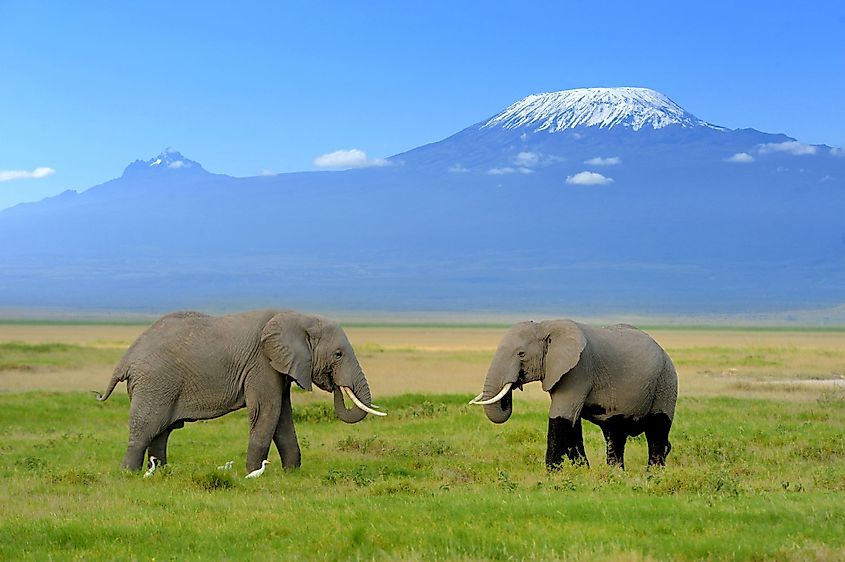
Sitting along its northern border with Kenya is Mount Kilimanjaro , the largest mountain in Africa. Sitting at roughly 5,895 meters (19,340 feet) tall, Kilimanjaro looms over the vast plains of the African savannah.
Climbing to the summit of the mountain is no easy feat, but reaching the top is certainly worth it. For those who have no interest in hiking up Kilimanjaro, there is a fantastic national park available. The park offers tons of tours led by accommodating and friendly guides.
Lake Manyara National Park
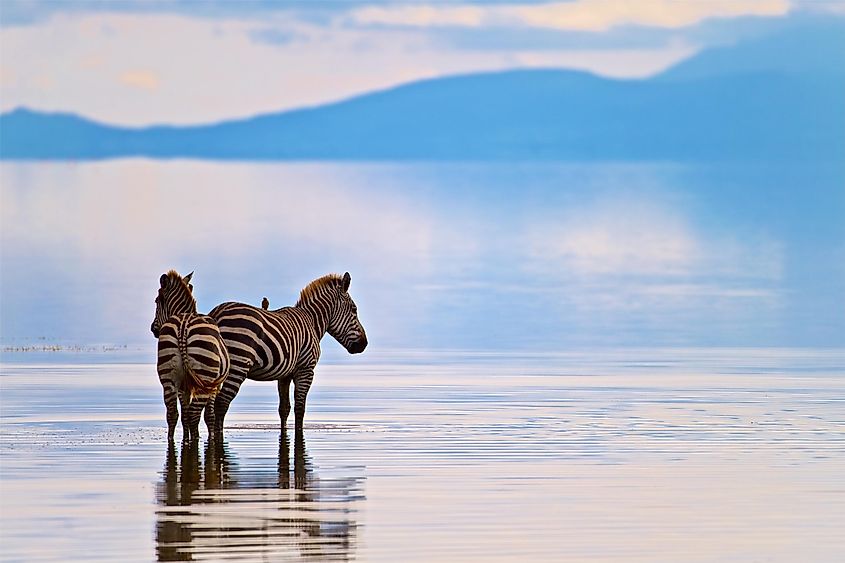
Found in the north of Tanzania, Lake Manyara National Park is another great destination for those wanting to get a closer look at the spectacular African wildlife. There are numerous tours available that grant visitors the chance to observe herds of elephants , curious giraffes, and even lion pride.
Aside from the traditional methods of looking at wildlife, there is also a tree-top canopy walk in some places. This gives the park's guests a new and unique way of viewing different kinds of primates and exotic birds. It is a great place to take friends and family.
Ngorongoro Crater
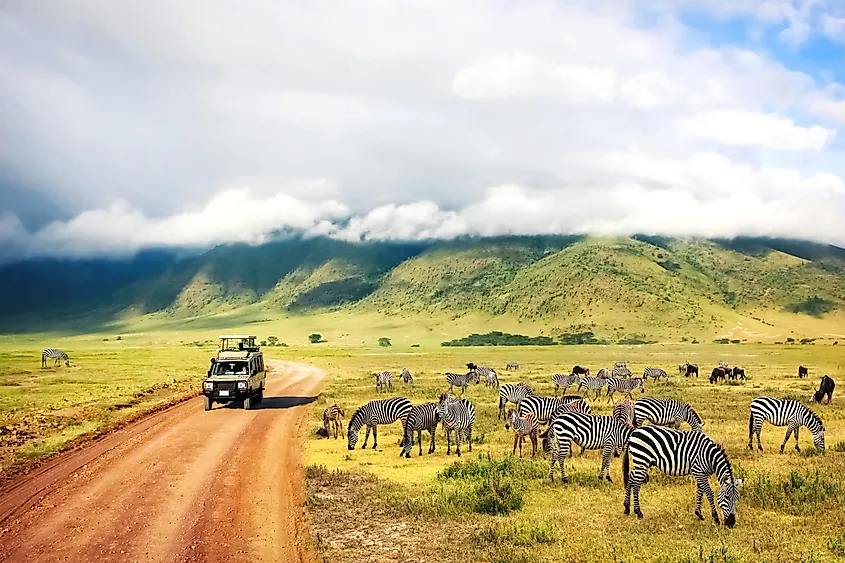
The Ngorongoro Crater is one of the world's largest inactive volcanic caldera . The surrounding area is teeming with wildlife and is the perfect place to go if you want to experience a more traditional safari. The land is home to all the stable animals one would expect, along with the semi-nomadic Maasai nomads who still live and hunt in the area.
There are dozens of high-end resorts guests have to choose from. If staying at a resort is not to your liking, then there are various campsites set up throughout the park that all come with a surprising amount of comfort despite being in the middle of the wilderness. The staff who work at these accommodations are more than happy to help and assist wherever they are needed.
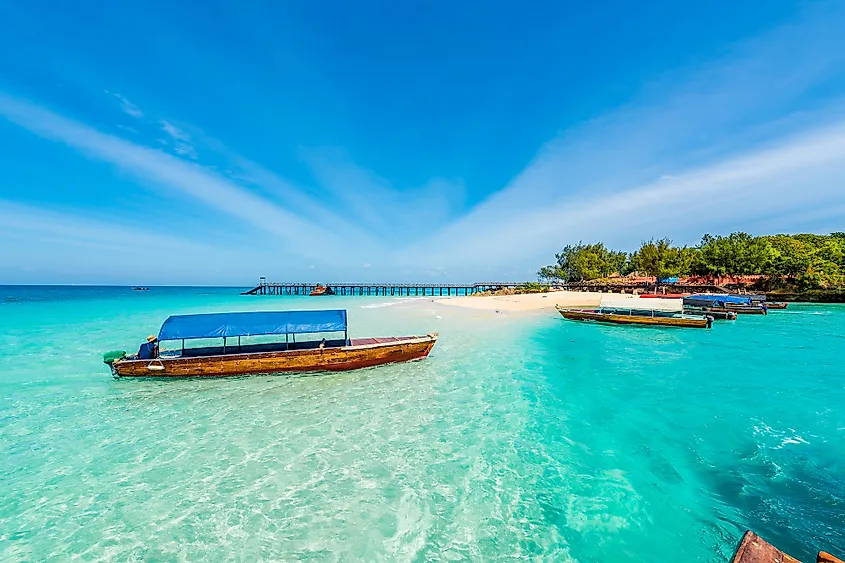
The Zanzibar Archipelago is located off the east coast of Tanzania. There is a lot to do in Zanzibar, and it has quietly become one of the most prominent tourist destinations in Tanzania. Whether you are looking for a relaxing time at the beach or want to explore the city itself, there is something here for everyone.
The Nakupenda Beach Nature Reserve is a great place to visit, especially for wadding in the warm turquoise blue water and shallow sandbank that the island is famous for. The old quarter of Zanzibar is another great attraction. Filled with a rich history and Arabian-infused architecture and culture, the city of Zanzibar is one of the more unique places in Africa. Its charm and energy are apparent the moment you arrive.
Discover Tanzania’s Hidden Charms
Tanzania is one of the best-kept secrets of Africa. Home to an endless amount of attractions and entertainment, it is no wonder more people are deciding to come and visit every year. No matter if you want to explore the county's wildlife or take a relaxing vacation on the beach, Tanzania has all of its bases covered.
More in Places

The Best Small Towns in Idaho for a Weekend Retreat

8 Most Affordable Towns to Retire in Arkansas

8 Most Affordable Towns to Retire in Montana
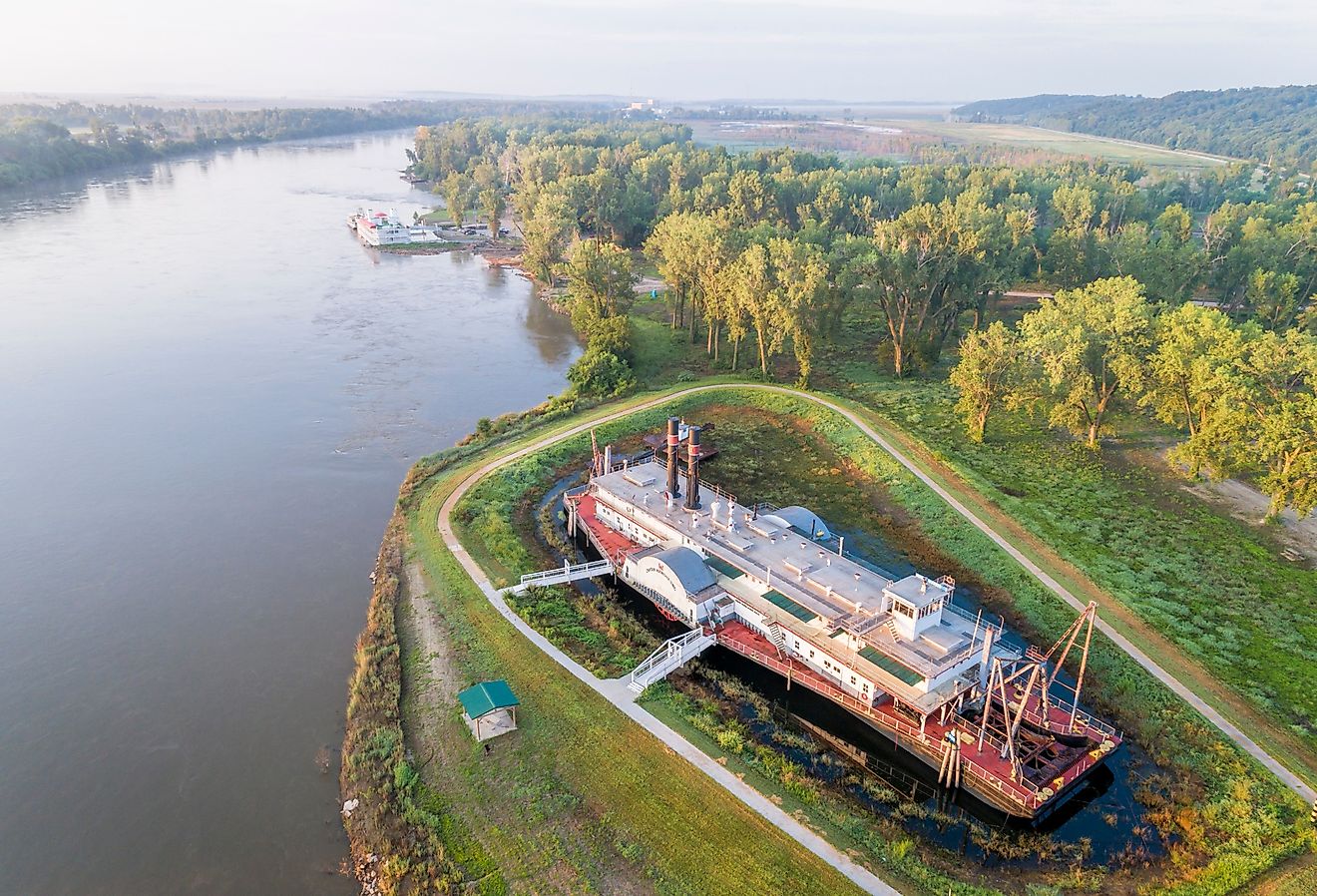
8 Breathtaking Towns to Visit in Nebraska
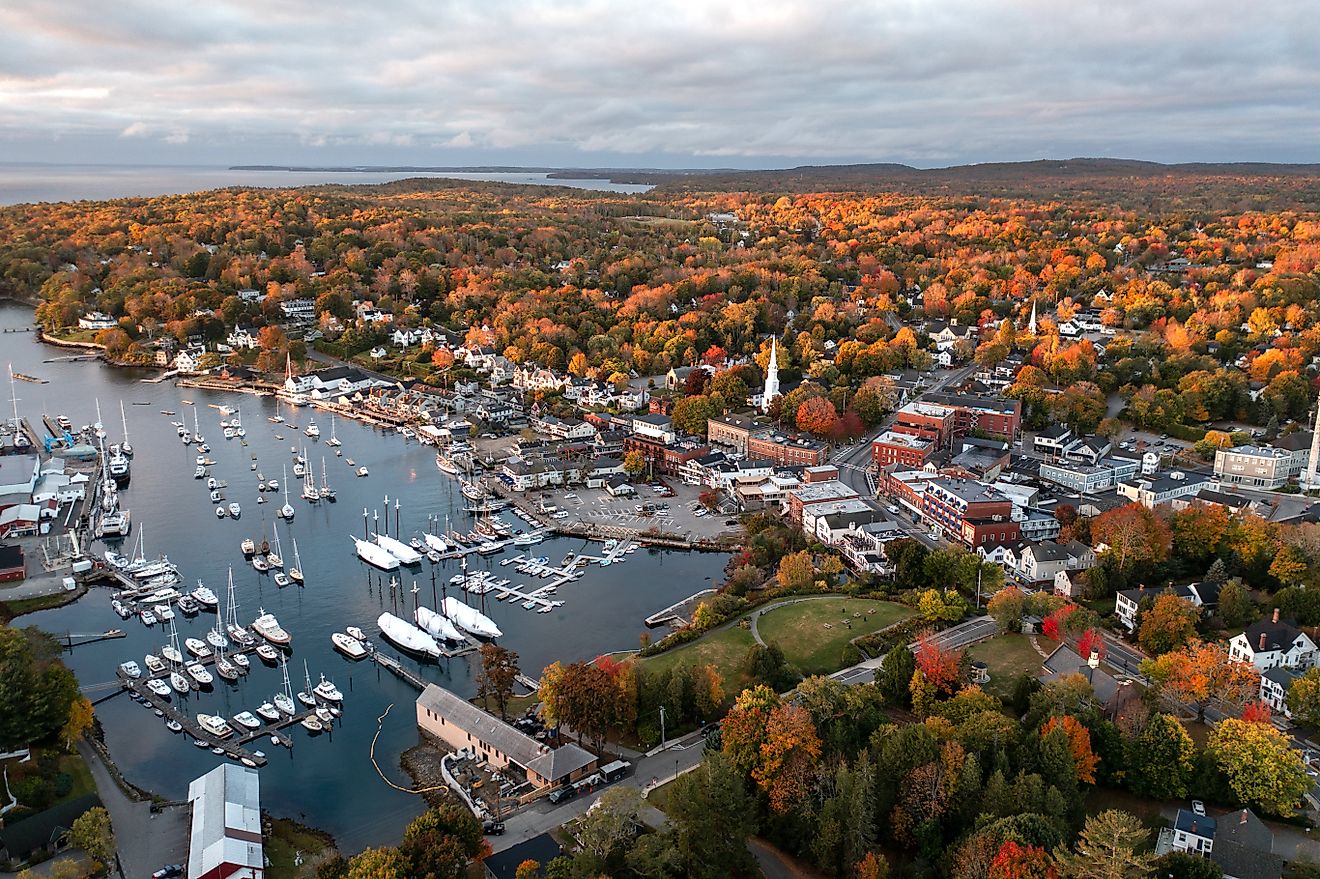
8 Towns Perfect For Retirement In New England
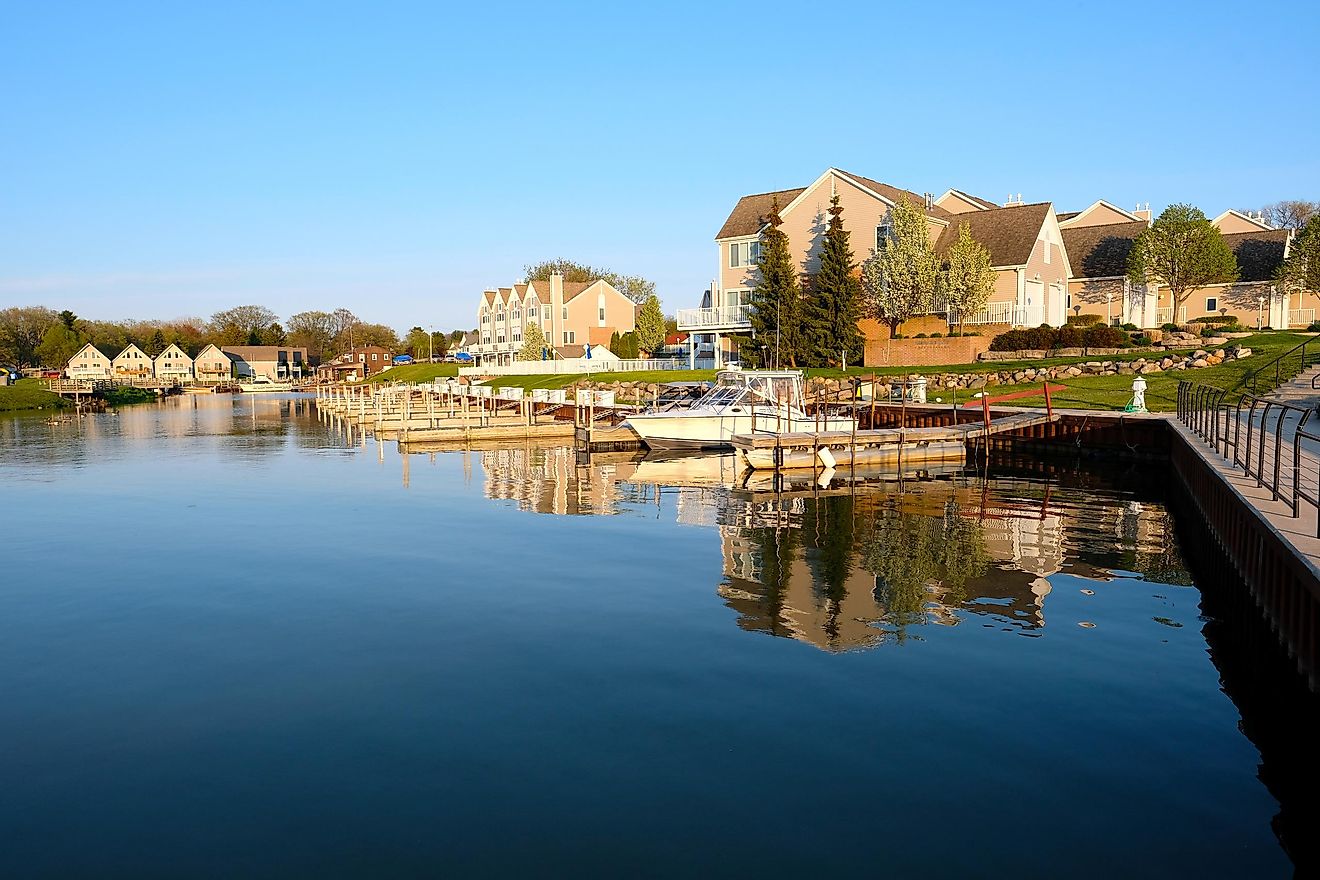
6 Most Idyllic Small Towns In The Great Lakes
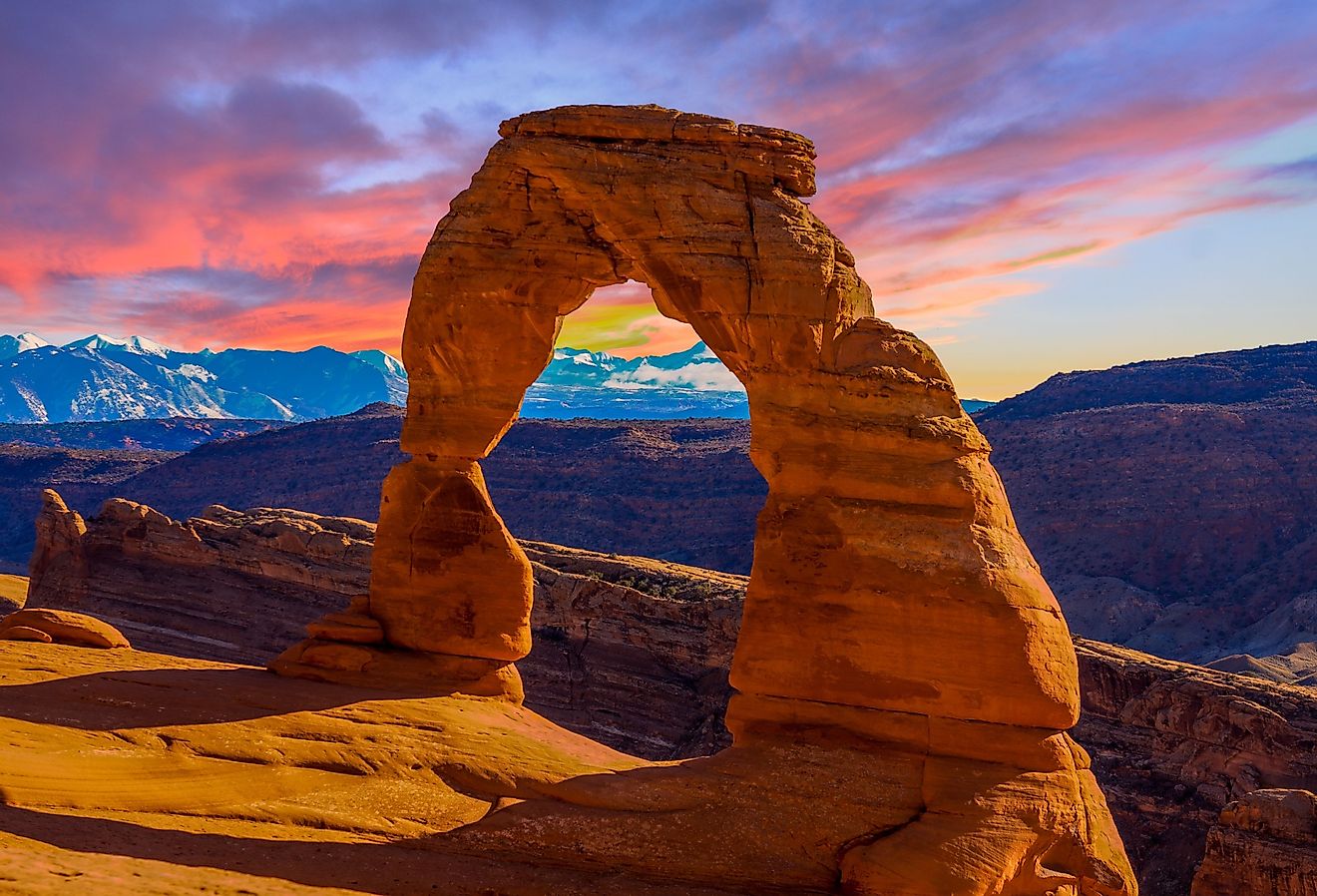
8 Cutest Small Towns In Utah To Visit In 2024
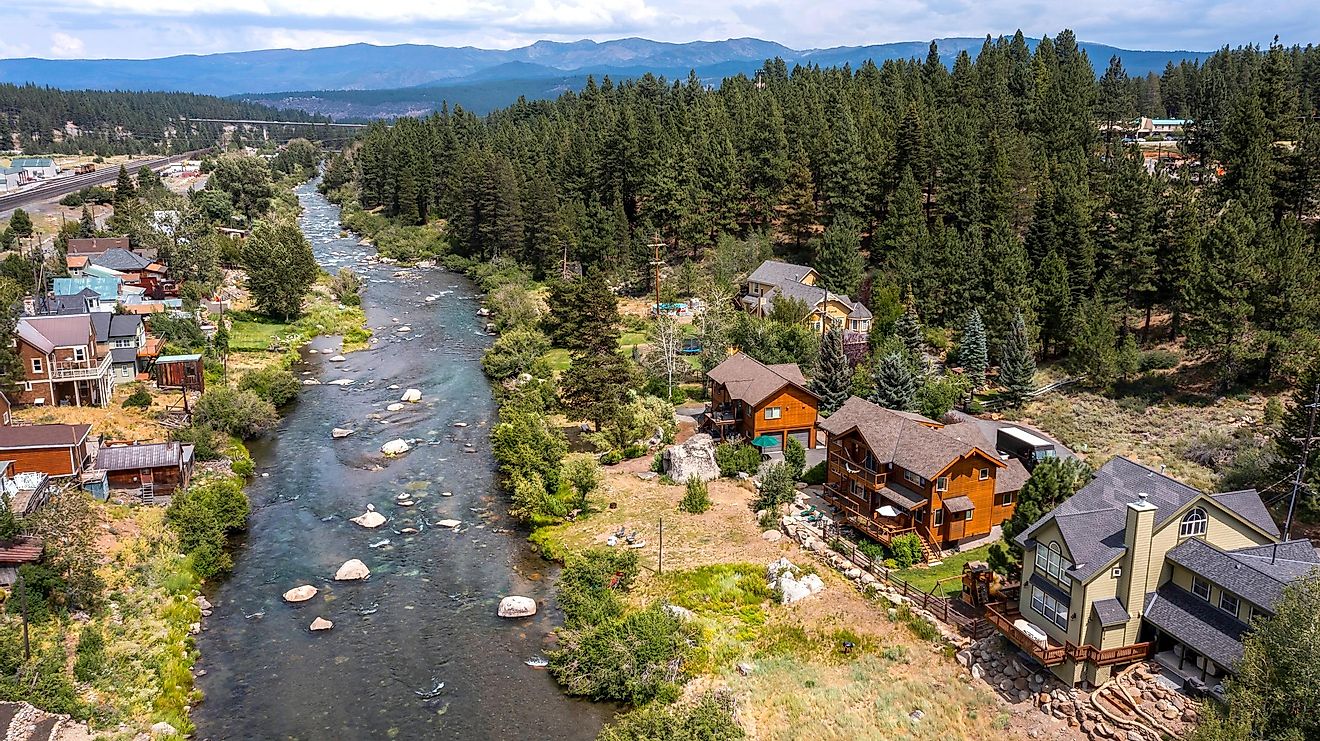
6 Most Inviting Towns In California's Sierra Nevada
Indigenous leaders are risking their lives to speak at the UN
From harassment to kidnapping and arrest, indigenous advocates who face reprisals for their work say the u.n. must protect them..
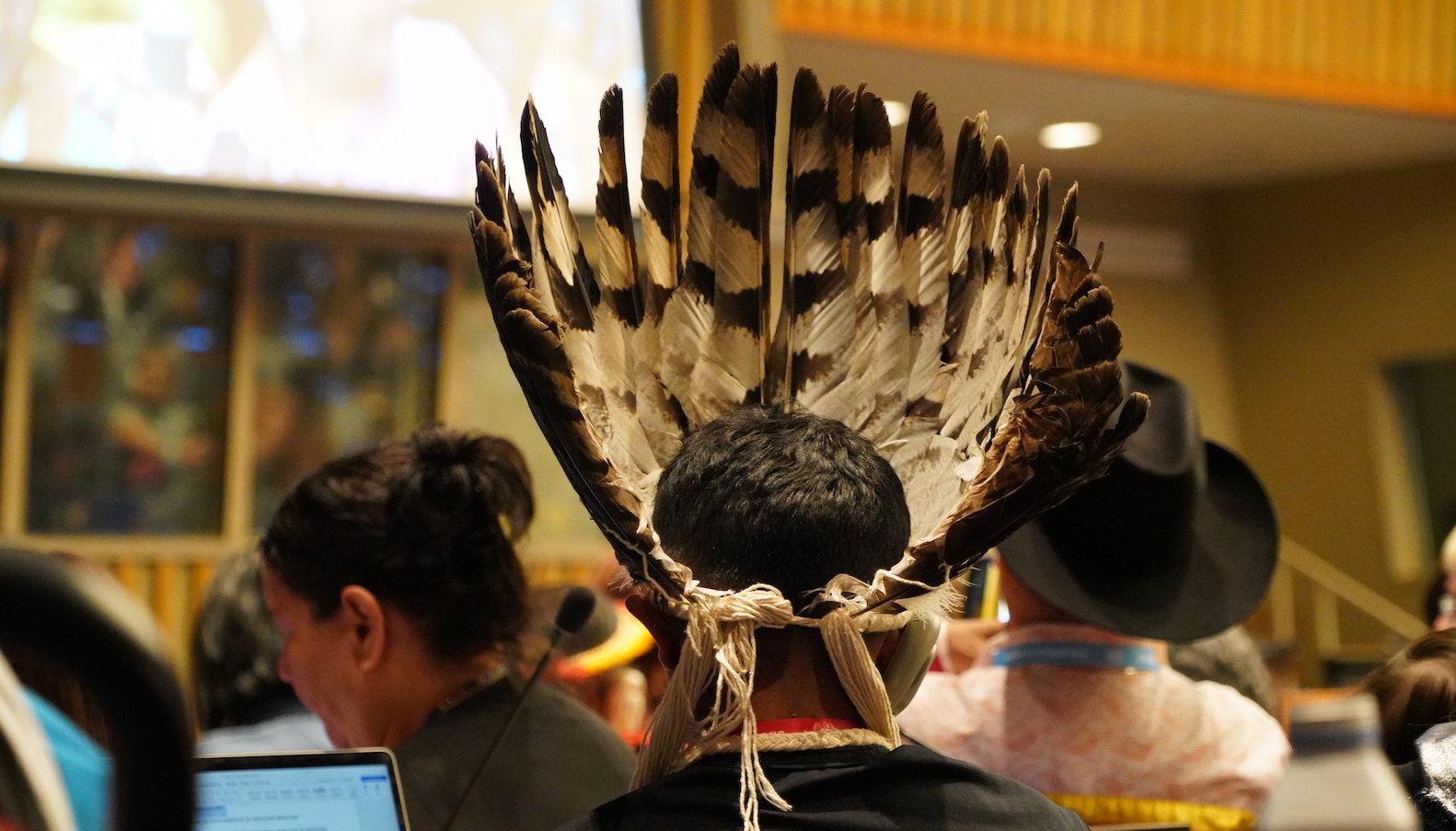
This story is published as part of the Global Indigenous Affairs Desk , an Indigenous-led collaboration between Grist, High Country News, ICT, Mongabay, Native News Online, and APTN.
Last September, Nicaraguan state security forces arrived at Indigenous Miskitu leader Brooklyn Rivera’s home in Bilwi, on the North Caribbean coast. Pretending to be health workers, officers allegedly handcuffed Rivera and beat him with batons before putting him in the back of an ambulance and driving away. More than six months later, Rivera’s family still doesn’t know where he is, or if he is alive.
Although Rivera had spent decades fighting for Miskitu autonomy and land rights, Carlos Hendy Thomas, another Miskitu leader, said that the recent targeting began with Rivera’s April 2023 trip to New York for the United Nations Permanent Forum on Indigenous Issues , or UNPFII, the world’s largest gathering of Indigenous leaders and activists, and a place for Indigenous peoples to bring attention to issues their communities face. Hendy Thomas said that before Rivera left for New York, government officials warned him not to speak out against the government. He did so anyway, and when Rivera tried to board a plane to return home, he was told that the Nicaraguan authorities had not approved his reentry. Instead, Rivera flew to Honduras and crossed the border back into Nicaragua to return to Bilwi.
A few days before his arrest, Hendy Thomas told Rivera he should leave the country for his own safety, but Rivera insisted his people needed him. That was the last time the two spoke. This year, Hendy Thomas came to the Permanent Forum to ask the United Nations to pressure Nicaragua for information. “We are hoping that by coming here, at least this would come to light, and the U.N. would intervene to get him out from jail, if he’s still in jail, or if he’s even alive,” Hendy Thomas said.
Grist thanks its sponsors. Become one .
To support our nonprofit environmental journalism, please consider disabling your ad-blocker to allow ads on Grist. Here's How
According to the Office of the United Nations High Commissioner for Human Rights , the number and severity of reprisals against people for engaging with the United Nations system has increased. Just in the past two years, Indigenous leaders attending U.N. meetings have faced attempted kidnapping, harassment, arrest, intimidation, online censorship, travel bans, smearing, and other forms of reprisal.
Hernan Vales, the chief of the Indigenous Peoples and Minorities Section at the Office of the United Nations High Commissioner for Human Rights, said that his office has seen an increase in reported cases of reprisals, but declined to give specific numbers. Vales and other U.N. experts also believe that there may be many more cases that go unreported. A 2023 U.N. report on the issue also says that more people are simply choosing not to engage with the U.N. because they are afraid of repercussions. According to the report, for example, 38 Indigenous Yukpa people decided not to meet with U.N. officials in Venezuela after being stopped by military forces while on their way to the gathering.
“We cannot tolerate those who bring critical perspective to the United Nations being silenced,” Vales said in a statement. “We need to do more.”
But even with the increased attention and resources available, UNPFII forum members, U.N. experts, and Indigenous leaders say that the problem is still getting worse. Roberto Borrero, who is president of the United Confederation of Taíno Peoples , has attended every session of the Permanent Forum since it began in 2002 and said that the frequency and severity of reprisals has increased, and that the U.N. needs to do more.
“It really speaks to the credibility of the U.N. to highlight and follow up on this issue,” he said. “If they don’t, the U.N. is going to be even more increasingly seen as ineffective.”

Last year, Edward Porokwa, an Indigenous Maasai leader from Tanzania, attended UNPFII to call attention to human rights violations carried out against Maasai communities, including forced evictions, land-grabbing, and resource deprivation . At the forum, said Porokwa, Tanzanian officials followed him, took videos and pictures without his permission, and said that he was not a legitimate representative. Porokwa said that throughout the forum, he also received anonymous phone calls saying that what he was doing was not right and the government was watching him.
In Tanzania, Maasai activists have faced arrest and persecution , and Porokwa, spooked by the warnings, decided not to return home for nearly six months. “It was very terrible,” he said. “I could not meet my family. I could not communicate with everybody, because they made me really feel like my life was in danger.” Despite the incident, Porokwa returned to UNPFII this year with an even larger delegation of Maasai leaders.
Indigenous leaders believe that governments are targeting their U.N. participation because it embarrasses them on the world stage. Exposing human rights abuses to the international community can also have financial impacts. Just this week, the World Bank announced that it is suspending $50 million in funding for a tourism project in Tanzania that has faced allegations of killings, forced evictions, and rape.
In a statement delivered at UNPFII, Hamisi Malebo, the executive secretary of the United Republic of Tanzania’s National Commission for UNESCO, denied what he called the “baseless and factually inaccurate” allegations made by Maasai leaders. “Tanzania is guided by the rule of law and respect for human rights,” Malebo said. “The government does not condone acts of threat, intimidation, and harassment of its citizens, human rights defenders, and other nonstate actors pursuing this common objective.”
Brian Keane, director of Land Is Life, a nonprofit that advocates for Indigenous rights, says that although threats at the U.N. tend to be less overt than cases like Rivera’s, intimidation and harassment should be taken just as seriously, especially knowing that they can lead to more serious repercussions back home. “It’s a big issue,” he said. “There’s this kind of constant bullying that goes on trying to silence people that are here to speak up for their rights,” he said.
On the second day of the two-week UNPFII session, Hindou Oumarou Ibrahim, Indigenous Mbororo from Chad and the chair of the forum, delivered a statement condemning any reprisals.
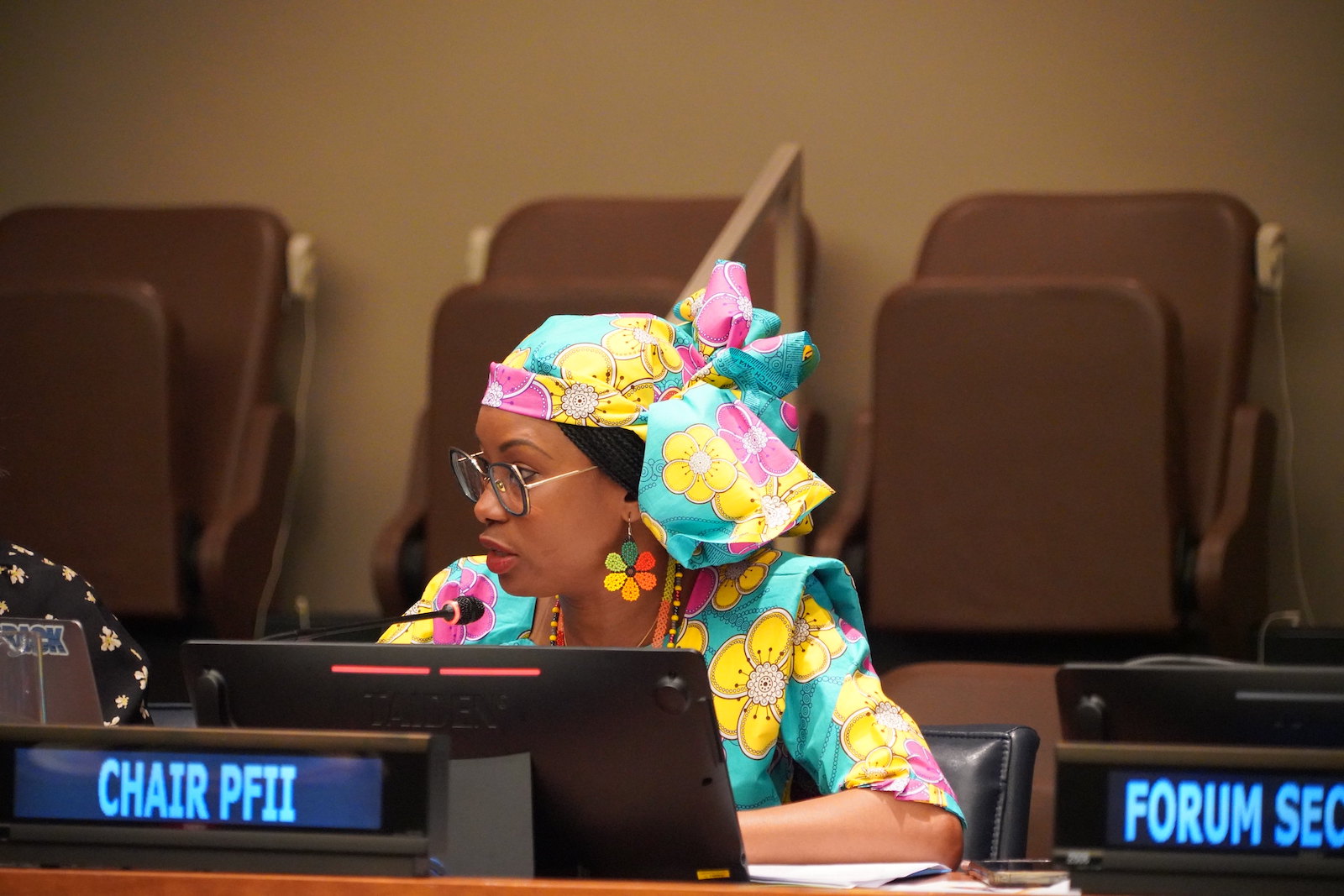
Last year, a young Indigenous woman from Asia whose name Grist is withholding to protect her identity, was on her way to her local airport to attend UNPFII, when her car was surrounded by a convoy of government vehicles. Officials attempted to drag her out of her car, and it was only after bystanders rushed to her defense that she was eventually permitted to leave. She said she is more careful now. But even after the experience, she returned to UNPFII this year. “I have to continue my work,” she said. “I see my meaning of life that way.”
In July 2022, Yana Tannagasheva, an Indigenous Shor activist from Kemerovo Oblast, Russia, attended a U.N. meeting in Geneva to speak about the harms of coal mining in her community. After she spoke, Tannagasheva and other witnesses say a Russian representative aggressively approached her and demanded to know her name and personal contact information. Tannagasheva, who has lived in exile in Sweden for six years, says the experience shattered her sense of security. “It was so awful. I wanted to cry,” she said. “I was surprised it can happen during a U.N. session.”
Representatives from the Bolivarian Republic of Venezuela, the Republic of Nicaragua, the Russian Federation, and the United Republic of Tanzania did not respond to requests for comment.
Binota Moy Dhamai, Tripura from the Chittagong Hill Tracts in Bangladesh and the chair of the Expert Mechanism on the Rights of Indigenous Peoples , said that reprisals threaten the entire international system and its goals. “If it continues like this then what is the meaning of talking about the sustainable development goals? What is the meaning of talking about peace-building?” he said.
Despite the risks, Carlos Hendy Thomas, from Nicaragua, has no plans to give up his fight. In 2020, Hendy Thomas’ son, who would have inherited his title of hereditary chief, was murdered. The murder, which Hendy Thomas believes was orchestrated by the state because of his son’s defense of Miskitu land rights, was never investigated. Hendy Thomas, who lives in the United States, says he is not that worried about his own safety, even though he is concerned about his family back home.
“I don’t really care about me,” he said. “They already killed my son. I’m afraid, but I’m speaking. If I don’t, who will?”
A message from
All donations DOUBLED!
Grist is the only award-winning newsroom focused on exploring equitable solutions to climate change. It’s vital reporting made entirely possible by loyal readers like you. At Grist, we don’t believe in paywalls. Instead, we rely on our readers to pitch in what they can so that we can continue bringing you our solution-based climate news.
Grist is the only award-winning newsroom focused on exploring equitable solutions to climate change. It’s vital reporting made entirely possible by loyal readers like you. At Grist, we don’t believe in paywalls. Instead, we rely on our readers to pitch in what they can so that we can continue bringing you our solution-based climate news.
UN puts spotlight on attacks against Indigenous land defenders
Global indigenous affairs desk, from australia to the arctic, young indigenous changemakers speak out, indigenous advocates at the un say the green transition is neither clean nor just, indigenous peoples rush to stop ‘false climate solutions’ ahead of next international climate meeting, a gigantic green energy transmission project will cut through indigenous lands in the southwest, a water crisis in mississippi turns into a fight against privatization, rivers are the west’s largest source of clean energy. what happens when drought strikes, republican attorneys general mount a new attack on the epa’s use of civil rights law, the more plastic companies make, the more they pollute, modal gallery.

20 Countries That Have The Potential To Be Major Tourist Destinations
I n this article, we shall discuss the 20 countries that have the potential to be major tourist destinations. To skip our detailed analysis of the global tourism industry in 2024, go directly and see 10 Countries That Have The Potential To Be Major Tourist Destinations .
Global Tourism Industry Outlook: Key Trends
According to World Tourism Barometer by the WTO, international tourism ended 2023 by reaching 88% of pre-pandemic levels, with more than 1.3 billion people engaging in outbound travel. The release of remaining pent-up demand, enhanced air and rail connectivity, and a robust recovery of Asian markets and countries that have the potential to be major tourist destinations is expected to catalyze a complete recovery by the end of 2024. According to a report by Deloitte, there are five major trends which are expected influence the travel industry in 2024, one of them being the meteoric rise of automated bookings. Although automated bookings are hardly a new phenomenon in travel, they are expected to skyrocket in 2024 and beyond, with the online booking market expected to reach $833 billion by the end of 2025 from $432 billion at the end of 2022. Closely related to this trend is an increased use of mobile phones, with the report citing that more than 70% of the global consumer base uses smartphones to make travel reservations. Furthermore, more than 72% of bookings take place within 48 hours of the first Google search. Thus, major players in the travel industry like Booking Holdings Inc. (NASDAQ: BKNG ), Airbnb Inc. (NASDAQ: ABNB ), and Expedia Inc. (NASDAQ: EXPE ) are divesting greater investments in targeted advertisements to effectively engage with the consumer's attention. Furthermore, these companies realize the short window they have to efficiently retarget customers with appropriate display ads based on prior activity and engagement.
Thirdly, corporate travel is looking at a strong resurgence in 2024 and is expected to reach more than 95% of pre-pandemic levels by the second half of 2024, although gains are decelerating. With macroeconomic and geopolitical headwinds disrupting operations in countries that have the potential to be major tourist destinations, business leaders are relatively much more stringent with travel spending in 2024. Although they recognize the significance of trips in fostering client relationships and facilitating cross-vertical collaboration, costs still emerge as a significant concern. More than 86% of corporate travel managers cite airfare as one of the biggest factors affecting companies' lack of willingness to travel. Despite this, US corporate travel spending is still expected to cross pre-COVID levels by the end of 2025.
According to McKinsey , more than 71% of consumers expect travel companies to offer personalized solutions and interactions, with more than 76% of consumers reporting frustration when this demand is not met. Thus, in a bid to win over the market, companies are ensuring that their interactions with consumers are tailored to their unique needs and preferences. Furthermore, it is also essential that advertisements target consumers' prior interactions, making consumer data invaluable for companies. Lastly, skyrocketing interest rates and elevated costs in countries that have the potential to be major tourist destinations have made it incredibly expensive to upgrade hotel and airline experiences. In a bid to navigate macroeconomic headwinds, companies are making continued investments in back-office technology and generative AI which may enhance operational efficiency and better align resources to demand.
As companies continue to capitalize on these trends, investor sentiment around major travel stocks continues to rise. One way to gauge increasing investor interest in the travel industry is by evaluating the performance of prominent travel-focused ETFs like Amplify Travel Tech ETF (NYSE:AWAY), which gives investors direct access to technology-focused equities within the global tourism industry. The ETF seeks investment results which mirror total return performance of the Prime Travel Technology Index NTR, and as of April 25, has more than 31 holdings including major players like Booking Holdings Inc. (NASDAQ:BKNG), Airbnb Inc. (NASDAQ:ABNB), and Expedia Inc. (NASDAQ:EXPE). In the last one year, the fund is up by more than 19.12% as of April 25. Another major travel-focused ETF is the Harvest Travel & Leisure Index ETF (TSE:TRVL), which provides investors with exposure to the growth trends in the travel industry driven by structural, demographic forces in countries that have the potential to be major tourist destinations . With more than 30 equities under management including prominent players like Booking Holdings Inc. (NASDAQ:BKNG), Marriot International Inc. (NASDAQ: MAR ), and Hilton Worldwide Holdings Inc. (NYSE: HLT ), the fund is up more than 6.93% year-to-date as of April 25.
Travel in the Metaverse: An Analysis
According to a report by McKinsey, the global travel industry is incredibly well-positioned for a virtual disruption. As the metaverse - a collective space wherein physical and virtual dimensions converge to generate a more immersive, interactive experience - becomes cheaper and faster to implement, if driven by proactive advertising and virtual events, could provide for a $20 billion opportunity by 2030, even in countries that have the potential to be major tourist destinations . As innovative formats become more common, new economic models are coming to the foreground. The travel experience of the future is expected to neither be completely online nor be a solely physical experience. Instead, companies across the world like Booking Holdings Inc. (NASDAQ:BKNG), Airbnb Inc. (NASDAQ:ABNB), and Expedia Inc. (NASDAQ:EXPE) are gearing for a more hybrid orientation, with virtual events, edutainment, and inspiration carefully balanced and integrated with physical destinations. One major way in which companies are dealing with this complexity is by implementing a traveler-first mentality. By empathizing with their target tourist, companies are able to better identify opportunities to integrate relevant virtual aspects.
During the pandemic, there was substantial global gravitation towards virtual concerts with significant surges in consumer demand, spending, and audience numbers. In 2020, the metaverse made up for a mere 0.1% of all live-music spending; by 2021, this figure has multiplied by ten-fold. According to the report, virtual events could make up for more than 20% of revenues by the end of the decade, owing largely to increased audience capacity at a fraction of the cost. With the metaverse expected to revolutionize multiple aspects of the global economy especially with regards to countries that have the potential to be major tourist destinations , travel is no exception, with virtual events promising enormous potential for the industry as a whole. However, in the short-term, opportunities may be fairly limited for a select key touchpoints, namely travel inspiration, events, and edutainment. End-to-end travel experiences are still further down the road.
Our Methodology
To compile our list of the 20 countries that have the potential to be major tourist destinations, we decided to create Insider Monkey's Tourism Potential Index by considering a conference paper from the 28th World Business Congress at the University of Cyprus. The paper used the Delphi technique to run a predictive analysis of future tourism and hospitality scenarios in different states. The paper identified three primary metrics through which the tourism potential of a particular country can be gauged, namely infrastructure and development, cultural heritage and attractiveness, and security. We decided to integrate this study with another research by Bloom Consulting, which measures the nation brands of countries in order to predict the international perceptions and reputation countries may have over a specific time period. Hence, to create Insider Monkey's own tourism potential index, we decided to consider four primary metrics, namely infrastructure and development (25 points), cultural heritage and attractiveness (25 points), security (25 points), and international perception and reputation (25 points).
Firstly, we decided to use the index in our article on the 40 Least Visited Countries in the World in order to shortlist 100 countries with low tourism numbers. In order to determine the tourism infrastructure in each country, we decided to use the index in our articles 30 Most Walkable Cities in the World and Top 20 Countries with the Best Roads in the World . In order to determine cultural heritage, we decided to use our article on the 35 Best Destinations in the World for Cultural Tourism . To determine security, we looked at the index in our article 30 Safest Countries in the World in 2024 . Finally, in order to determine international perception and reputation, we decided to use Bloom Consulting's predictive analysis of nation brand value in the coming years.
We created primary rankings for each metric by listing the top 50 countries in each of the four areas, namely infrastructure and development, cultural heritage and attractiveness, security, and international perception and reputation. As expected, there was significant overlap amongst all four primary lists. Then, we assigned points to each country based on their relative position in each primary list. For instance, if a country ranked number 1 on a list, it received 25 points. If it ranked second, it received 24.5 points, and so on. We then tabulated the total number of points scored by each country out of 100 to arrive at a cumulative score for each entry. We then ranked each entry based on these cumulative scores, from lowest to highest.
By the way, Insider Monkey is an investing website that tracks the movements of corporate insiders and hedge funds. By using a similar consensus approach we identify the best stock picks of more than 900 hedge funds investing in US stocks. The top 10 consensus stock picks of hedge funds outperformed the S&P 500 Index by more than 140 percentage points over the last 10 years ( see the details here ). Whether you are a beginner investor or a professional looking for the best stocks to buy you can benefit from the wisdom of hedge funds and corporate insiders.
20. Albania
There are various reasons which suggest that Albania has the potential to become one of the top tourist destinations. The country is home to beautiful landscapes, as well as some cultural heritage spots that have been identified as UNESCO World Heritage Sites.
19. Romania
While visiting Romania, one can engage in a wide range of outdoor activities at any time of the year, including hiking, dog-sledding, and biking. This increases its chance of becoming a major tourist destination in the future.
18. El Salvador
Initially, El Salvador was not considered to be a safe country; however, over the years, the country has been making efforts to improve its safety situation. The country is known primarily for its beautiful coastline and plenty of volcanoes, and thus makes our list of countries that have the potential to be major tourist destinations.
17. Mauritius
Mauritius is considered to be an extremely safe country for tourists since the crime levels are low. It is known to be one of the most peaceful countries in Africa. The people of Mauritius are known to be extremely friendly and warm.
In recent years, the tourism infrastructure has developed greatly in Kenya, which includes the development of hotels and adventure activities for tourists. The country is mainly known for its wilderness and national parks, and thus makes our list of countries that have the potential to be major tourist destinations.
Despite its history of political conflict, Iran has the potential to become a travel destination in the near future. The country is home to various ancient cities including Persepolis and Hamedan. Additionally, it also offers a multitude of activities to its visitors, like skiing and sunbathing.
14. Tanzania
The National Tourism Policy in Tanzania aims to promote the livelihood of people by developing sustainable tourism practices and encouraging quality tourism. Additionally, the people of Tanzania are known to be extremely hospitable and warm.
Even though Zambia is one of the most-visited countries, it has the potential to become a major tourist destination in the coming years. The country is primarily known for Victoria Falls and National Parks.
12. Botswana
Botswana is known for its diverse and unique wildlife experience, which includes lions, elephants, cheetahs, and zebras. Botswana consistently makes efforts to protect its wildlife, which may attract many tourists in the coming years.
11. Namibia
Namibia is one of the safest countries in Africa and is slowly working towards developing and expanding its tourist infrastructure including tour operators and hotels. The country is also home to extremely diverse landscapes, and hence makes our list of countries that have the potential to be major tourist destinations.
Click here to continue reading and see 10 Countries That Have The Potential To Be Major Tourist Destinations .
- 10 Stocks American Politicians are Buying in 2024
- 10 Best Soaps and Cleaning Materials Stocks to Buy
- 20 U.S. Cities Most People Moved To: 2024 Rankings
Disclosure: None. 20 Countries That Have The Potential To Be Major Tourist Destinations is originally published on Insider Monkey.
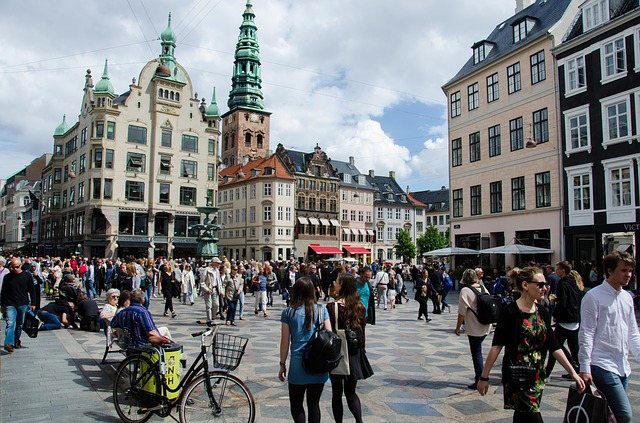
- Share full article

Flooding Inundates Kenya, Killing at Least 32 and Displacing Thousands
Heavy rains also pounded other nations in East Africa, including Tanzania, where at least 155 people were killed, according to the country’s prime minister.
Residents in Nairobi were stranded on Tuesday after a night of heavy rainfall. Credit... Daniel Irungu/EPA, via Shutterstock
Supported by

By Abdi Latif Dahir and Jesus Jiménez
Abdi Latif Dahir reported from Nairobi, Kenya, and Jesus Jiménez from New York.
- April 24, 2024
Days of torrential rains have pummeled parts of Kenya, leaving at least 32 dead, 15 injured and more than 40,000 people displaced, according to officials. The flooding has killed nearly 1,000 farm animals and destroyed thousands of acres of crops, with more rain expected across the country in the coming days.
The rains began in March during what is known in the country as the “long rains,” but intensified over the past week, according to the Kenya Meteorological Department .
Heavy rains have also pounded other nations across East Africa. In Tanzania, at least 155 people were killed and 236 others injured from the relentless rain that has swept several parts of the country in recent days, Prime Minister Kassim Majaliwa said on Thursday.
The rains affected some 200,000 people, Mr. Majaliwa added, and caused damage to farms, bridges, roads, schools and places of worship. The Tanzania Meteorological Authority warned that heavy rains and strong winds would continue to pummel several towns and cities, including the port city of Dar es Salaam.
In Kenya’s capital, Nairobi, where some of the country’s heaviest rain has fallen, more than 30,000 people have been displaced, according to the United Nations Office for the Coordination of Humanitarian Affairs . On Tuesday, 18 people there were stranded and later rescued, including seven children, the Kenya Red Cross Society said.
Edwin Sifuna, the Nairobi County senator, said on social media that the local government there was “clearly overwhelmed,” and he called on the federal government for help.
“The situation in Nairobi has escalated to extreme levels,” he wrote in a post that included a video of people stranded on rooftops surrounded by floodwaters.
Kithure Kindiki, cabinet secretary for the Interior Ministry, said in a social media post on Thursday that several government agencies were beginning a joint operation to assist the victims, conduct rescues and evacuate those who remain at risk.
The heavy rains on Wednesday forced Kenya Railways to suspend commuter train services. The Kenya Urban Roads Authority also partially closed four major roads in Nairobi and warned of heavy flooding along several major highways in the capital and in the coastal city of Mombasa.
The rains were not expected to subside over the next few days, according to the Kenya Meteorological Department, which had rain in the forecast for parts of the country, including Nairobi, through Monday. The agency also warned of a high likelihood of breakouts of diseases such as malaria and diarrhea in some areas.
The latest downpours come just months after torrential rains and floods killed dozens of people and displaced thousands more nationwide.
Here are photographs of the flooding in Kenya:
A flooded river in Mathare, a sprawling shantytown in Nairobi where many live in tin shacks.
Swimming through floodwaters to try to rescue people stranded in their homes in Mathare. Most of those displaced in Nairobi live in informal settlements, according to the United Nations.
Residents of Mathare tried to salvage goods from their homes. Many people in Nairobi live in high-density areas that lack proper roads, water or power infrastructure.
Residents in Mathare trying to clear muddy water from their homes. Missing or blocked drainage systems have been blamed for exacerbating the floods.
Clinging to buses and trucks to avoid flooded roads in Nairobi.
Homes in several neighborhoods across the capital were submerged, leading to evacuations.
The torrential rains affected almost half of Kenya’s 47 counties, according to the United Nations.
Using a boat to traverse floodwaters in the Githurai area of Nairobi.
Flooding inundated entire roadways in Machakos County, about 35 miles southeast of Nairobi.
The swollen Athi River. The river burst its banks and flooded homes in Machakos County, officials said.
Abdi Latif Dahir is the East Africa correspondent for The Times, based in Nairobi, Kenya. He covers a broad range of issues including geopolitics, business, society and arts. More about Abdi Latif Dahir
Jesus Jiménez covers breaking news, online trends and other subjects. He is based in New York City. More about Jesus Jiménez
Advertisement

Page 1 of 2
- You are here:

- Tourism Statistics

IMAGES
COMMENTS
In 2023, tourist arrivals to Tanzania increased by 24.3% to a record-breaking 1,808,205, from 1,454,920 tourists in 2022, 922,692 in 2021, and 616,491 in 2020. Tanzania's tourism receipts reached a record-high USD 3,368.7 million in 2023, compared to USD 2,527.8 million in 2022 (USD 1,310.3 million in 2021). This increase is consistent with ...
Let's reimagine the future of Tourism in Tanzania. Tanzania's tourism sector is seeing a rebound after the Covid-19 pandemic—and the aspirations for its continued growth are high: by 2025, the country hopes to reach $6 billion in tourism revenue, which assumes the influx of five million tourists annually. To achieve such lofty goals will ...
Tanzania is a globally recognized destination for nature-based tourism, a competitive market segment in eastern and southern Africa. Beyond attracting tourists, the country's landscapes and seascapes produce a wide range of ecosystem services, including carbon sequestration and biodiversity co-benefits that are not efficiently priced and often generate little or no financial return.
Holidaymakers had the highest average expenditure of USD 243. The number of international visitors increased by 57.7 percent to 1,454,920 in 2022, from 922,692 recorded in 2021. Correspondingly, international tourism earnings rose by 92.3 percent to USD 2,527.8 million in 2022, from USD 1,310.3 million in 2021.
International Visitors' Exit Survey Report 2022. Tourism Sector continued to be among major sources of Tanzania's foreign earnings in 2022. Earnings from tourism rose by 92.3 percent to USD 2,527.8 million, from USD 1,310.3 million registered in 2021. During the period, international arrivals increased to 1,454,920, from 922.692 reported in ...
Based on these attractions and Government efforts to market and implement its tourism policy and strategic plans, Tanzania has shown a tremendous growth with number of international visitors increasedby 57.7 percent to 1,454,920 in 2022, from 922,692 recorded in 2021. Consequently, international tourism earnings increased to
Show plans. Dar es Salaam. Tanzania's tourism sector is seeing a rebound after the Covid-19 pandemic—and the aspirations for its continued growth are high: by 2025, the country hopes to reach $6 billion in tourism revenue, which assumes the influx of five million tourists annually. To achieve such lofty goals will require some important ...
Dar es Salaam. Tanzania has started 2024 with a notable surge in tourist arrivals, raising expectations for a continued industry upswing after full recovery from the Covid-19 pandemic's woes. The expectations are anchored on the arrival on Tuesday January 16 at the Dar es Salaam port of a ship carrying 2,340 passengers and more than 1,100 ...
Appendix C1: Tourism Business Trends in Tanzania, 2014 - 2019 ..... 64 Appendix C2 : Percentile of Average Expenditure of International ... TTB Tanzania Tourist Board TUN Tunduma UNWTO United Nations World Tourism Organization URT United Republic of Tanzania
Assuming the growth of 36 percent continues for the next two years, the receipts from tourist arrivals would reach USD 6. 3 billion by December 2025. In addition, if as a Country, we generated USD 3.4 billion with only 1.8 million tourist arrivals, one can argue that we do not need 5 million tourists to generate USD 6 billion.
The Travel & Tourism market in in Tanzania is projected to grow by 5.32% (2024-2028) resulting in a market volume of US$1,034.00m in 2028.
In terms of international tourism receipts, Tanzania exhibits a unique trend as compared to other emerging economies in Africa. For instance, over the period 2010-2019, the average international tourism receipt (% of total exports) for Tanzania was 23.95%, Uganda 21.17%, Kenya 16.22%, South Africa 9.24%, Ghana 5.85% and Mozambique 4.68% ...
Tourism show - it is an event which provides a unique opportunity to showcase tourism products and services, meet, network, negotiate and conduct business with domestic and international tourism stakeholders. International visitor - person who travels to a country outside his/her usual
Abstract. This chapter critically evaluates how Tanzania could increase the number of international tourists' arrivals, and in turn, enhance the sector's effectiveness in contributing to the country's second 5-year development plan. It empirically investigates the relevant determinants of international tourism demand for Tanzania and uses ...
Tanzania is a country with many tourist attractions. Approximately 38 percent of Tanzania's land area is set aside in protected areas for conservation. [1] There are 17 national parks , [2] 29 game reserves, 40 controlled conservation areas (including the Ngorongoro Conservation Area ) and marine parks.
Tanzania tourism statistics for 2018 was 2,465,000,000.00, a 8.83% increase from 2017. Tanzania tourism statistics for 2017 was 2,265,000,000.00, a 5.4% increase from 2016. Tanzania tourism statistics for 2016 was 2,149,000,000.00, a 11.69% increase from 2015. International tourism receipts are expenditures by international inbound visitors ...
Tanzania Tourism Sector Survey Report 2019. On development, tourism continues to be an important source of Tanzania's foreign earnings. In 2019, earnings from tourism increased by 7.9 percent to USD 2,604.5 million, from the level registered in 2018 following the increase in the number of international visitors to 1,527,230, from 1,505,702 ...
Number of visitors to national parks in Tanzania 2015-2019, by type. Average expense at selected beach destinations in Tanzania, by cost factor 2018. Main nationalities of tourists arriving in ...
limited research on sustainability in tourism in Tanzania. Hence it aimed to produce a high-quality research output necessary for making informed policy and planning decisions for the sector, improved quality standards of tourism resources and services and an increased understanding of aspects of tourism and sustainable development in Tanzania.
From the majestic wildlife of sprawling savannahs to the mesmerising beauty of the Indian Ocean's coastline, experience the essence of Africa. Taste, savor, and embrace the diverse cultures and landscapes that make Tanzania truly unforgettable. Always be part of the grand celebration of nature, heritage, and hospitality.
Tanzania safari. One prominent trend in Tanzania's tourism is the increasing emphasis on sustainability. With its breathtaking landscapes, diverse ecosystems, and abundant wildlife, Tanzania ...
In 2021, the contribution of the tourism sector to Tanzania's economy slightly increased to six percent, up from 5.7 percent in 2020. That year, the sector felt the most the impact of the coronavirus (COVID-19) pandemic. Despite the improvement, tourism contribution to Tanzania's GDP remained below the level previous to the health crisis.
Another one of Tanzania's stellar national parks, the Mahale Mountains, is located along the tranquil shores of Lake Tanganyika in eastern Tanzania. Initially created to protect a large segment of Tanzania's chimpanzee population, the park has become a world-class tourist destination. The Greystone Mahale Camp is particularly stunning.
Just this week, the World Bank announced that it is suspending $50 million in funding for a tourism project in Tanzania that has faced allegations of killings, forced evictions, and rape.
Global Tourism Industry Outlook: Key Trends. According to World Tourism Barometer by the WTO, international tourism ended 2023 by reaching 88% of pre-pandemic levels, with more than 1.3 billion ...
Whether basking in the tranquility of a secluded beach or meandering through serene countryside landscapes, these experiences contribute to self-care and overall well-being. Discover the top quiet travel trends below 3: Solo travel +35%. Travel journal pages +155%. Glamping aesthetic +260%. Wellness retreat aesthetic +90%. Cabin in the ...
Heavy rains also pounded other nations in East Africa, including Tanzania, where at least 155 people were killed, according to the country's prime minister. In Photos Heavy rains also pounded ...
Tourist Arrivals for the Period of January to February, 2023. Press Release Tourist Arrivals January to December, 2022. Tanzania Tourism Sector Survey Report 2019. Tanzania Tourism Sector Survey Report 2018. Tourist Arrivals for the Period of January to July 2022. Tourist Arrivals for the period of January to May 2022.